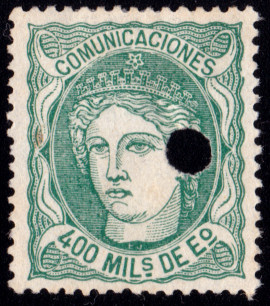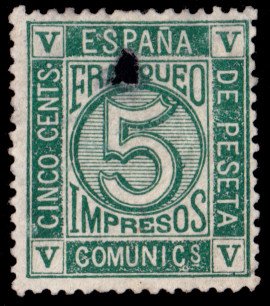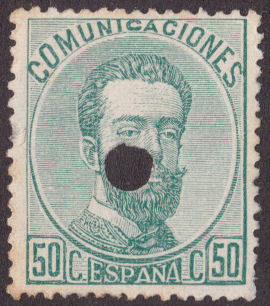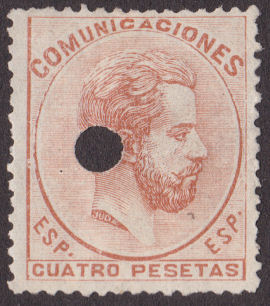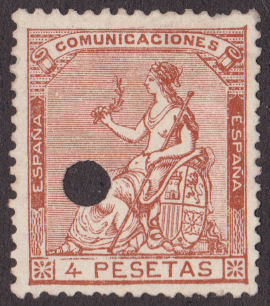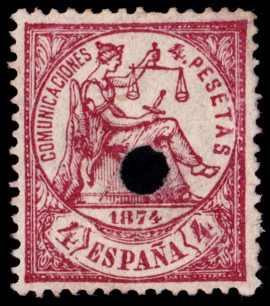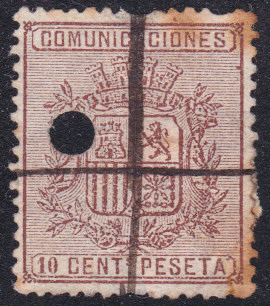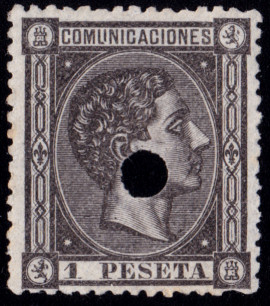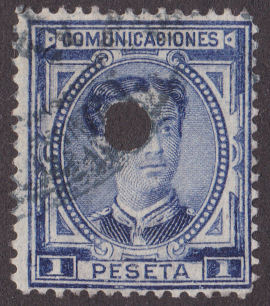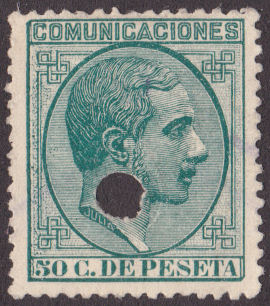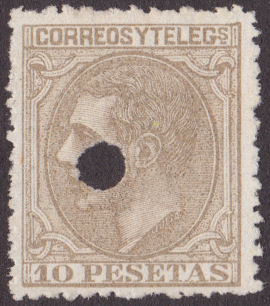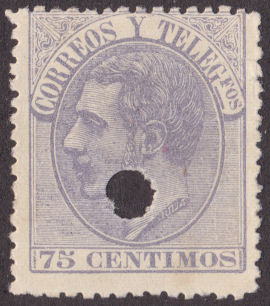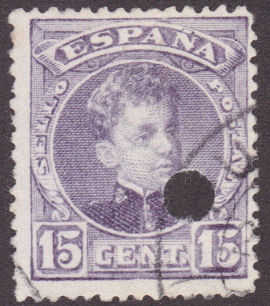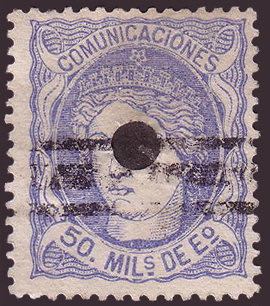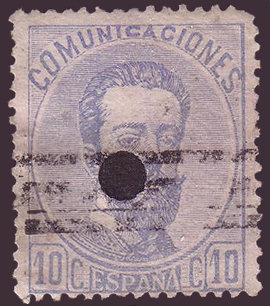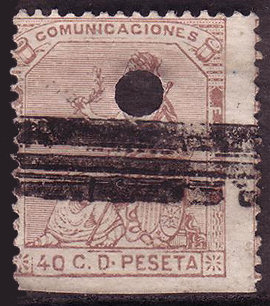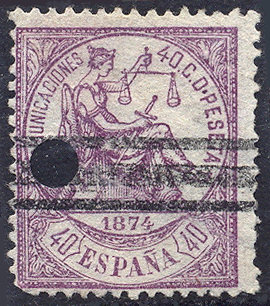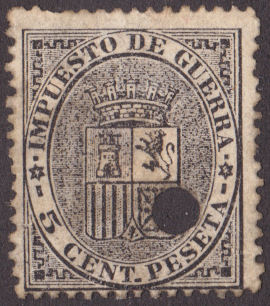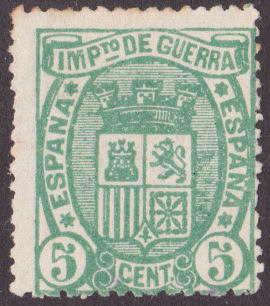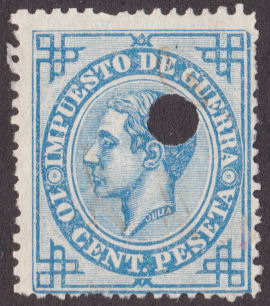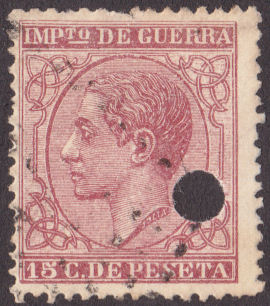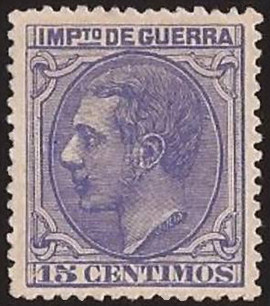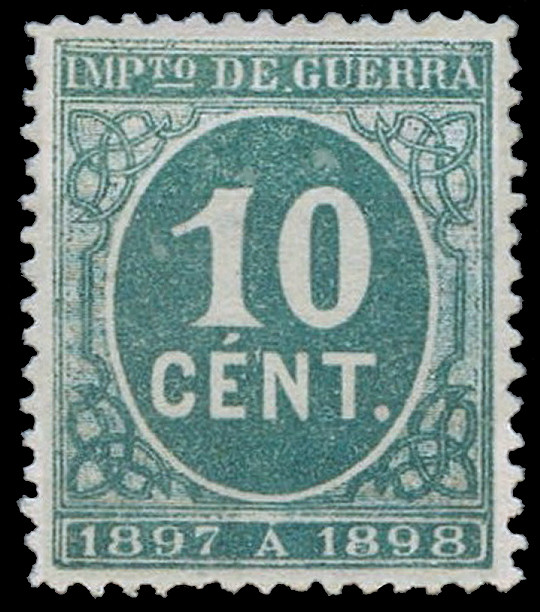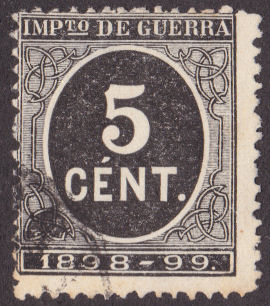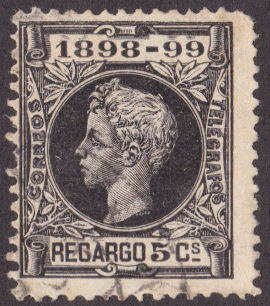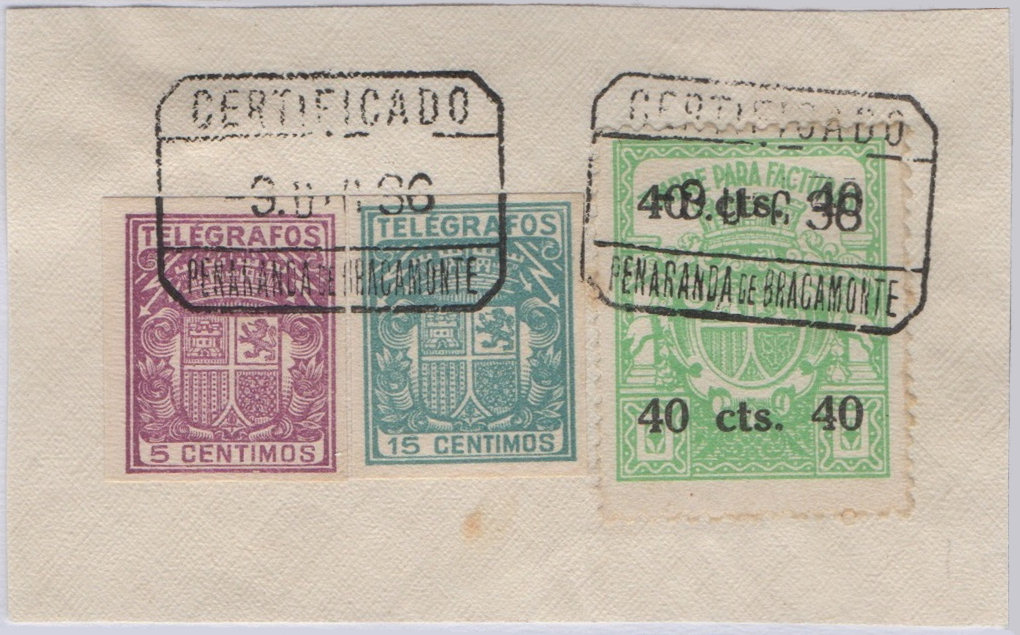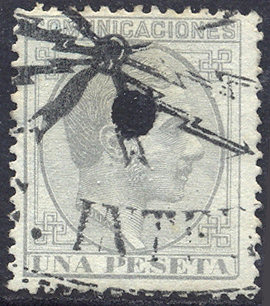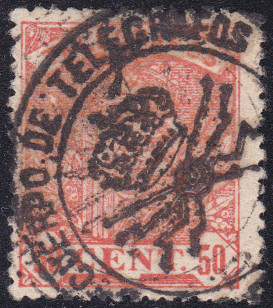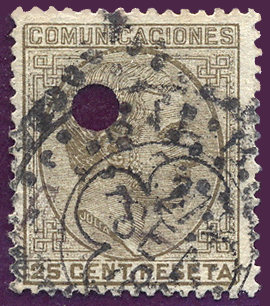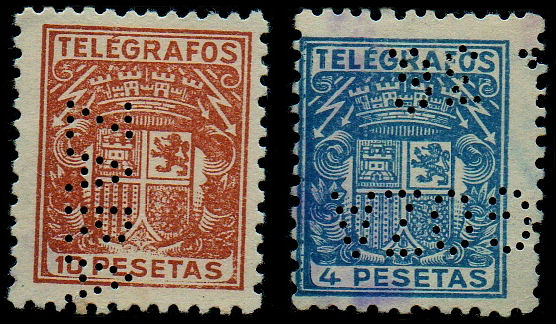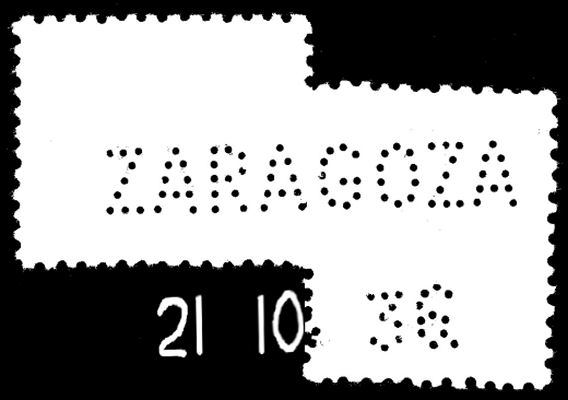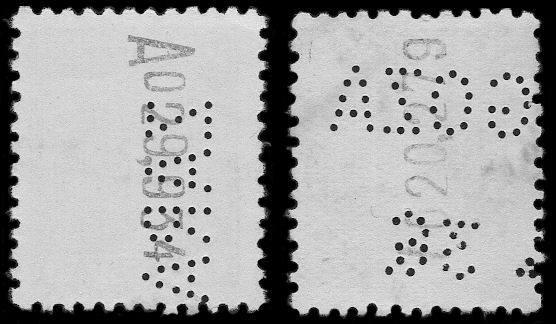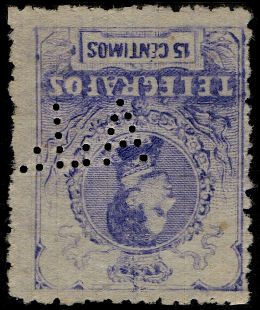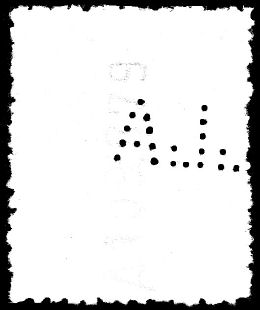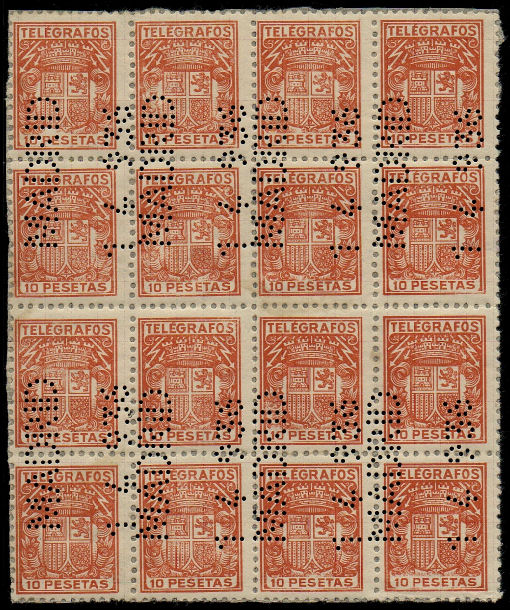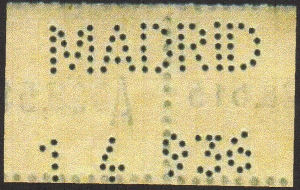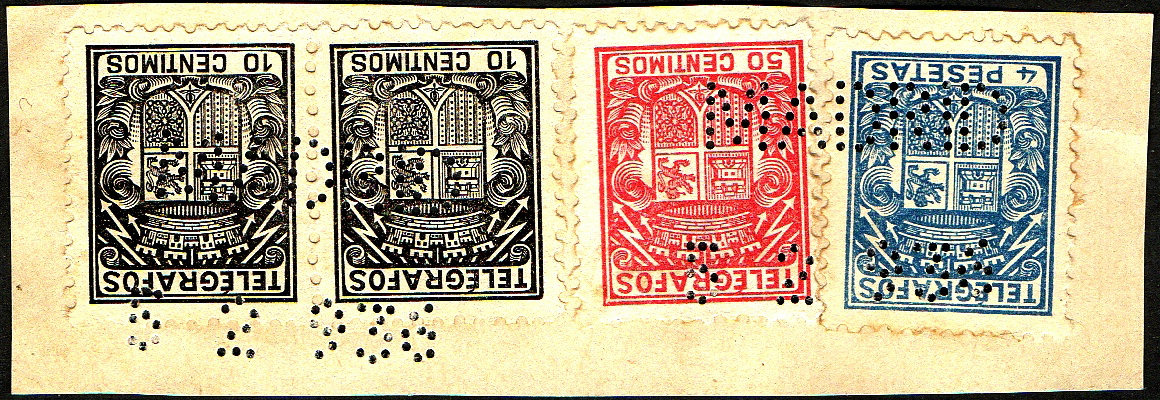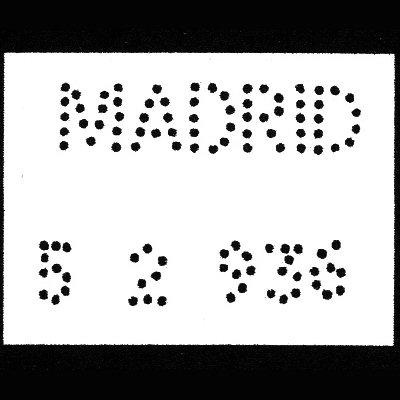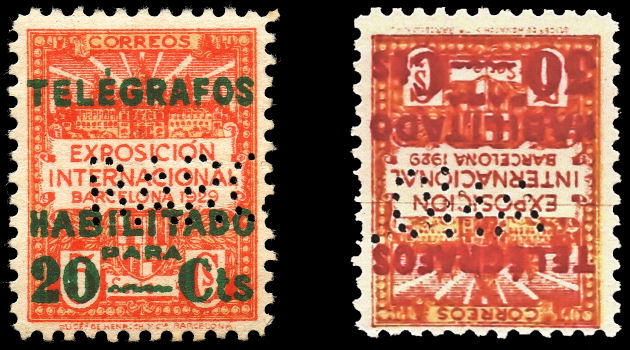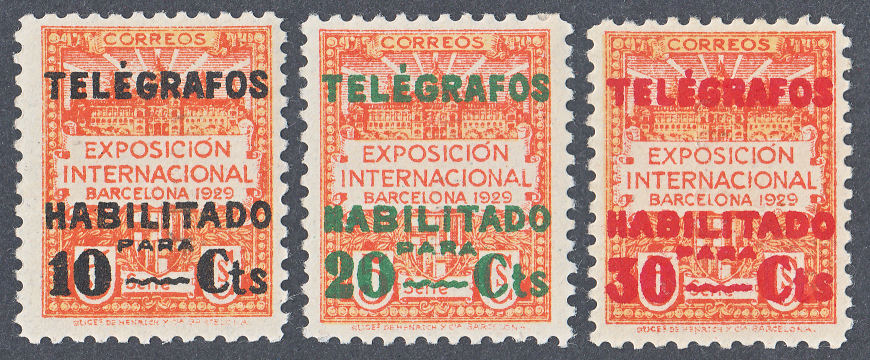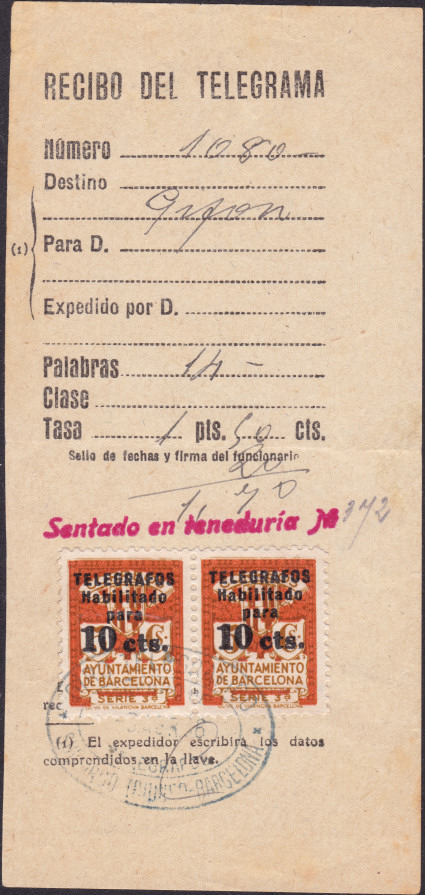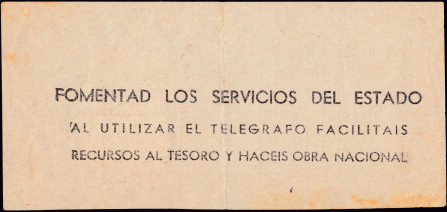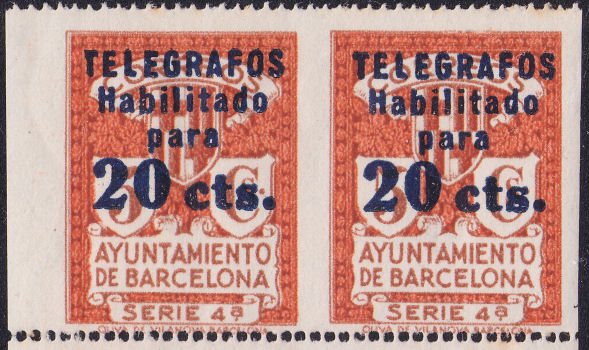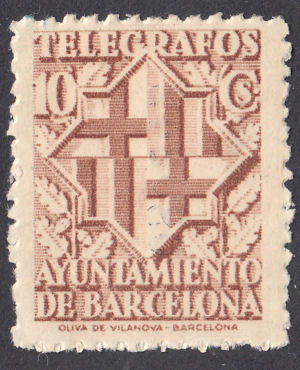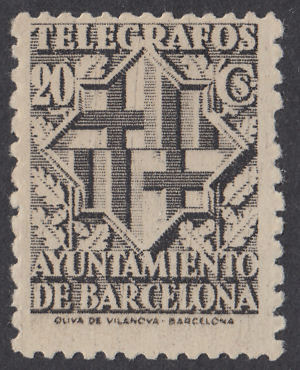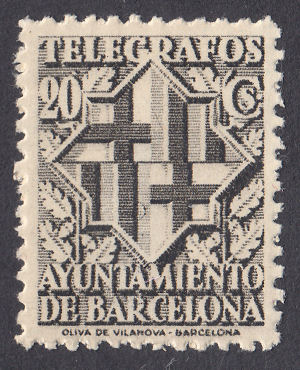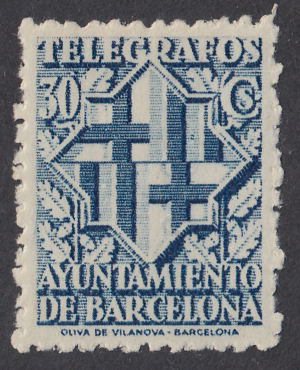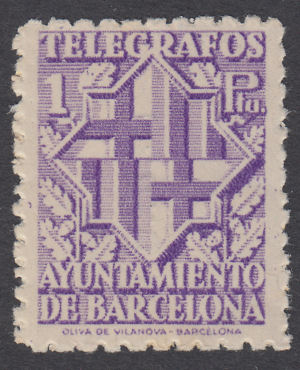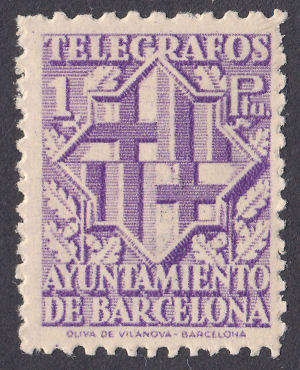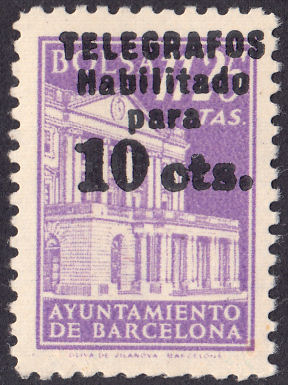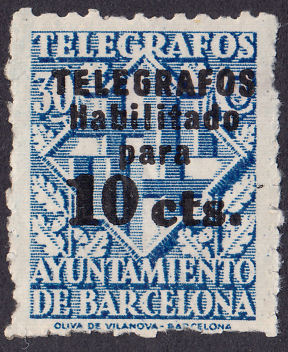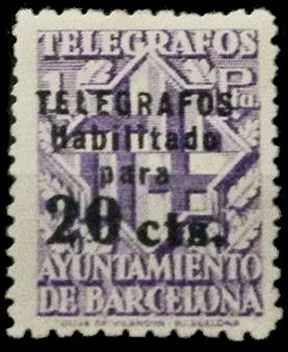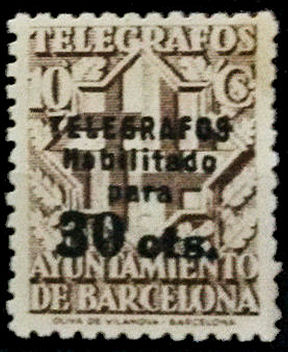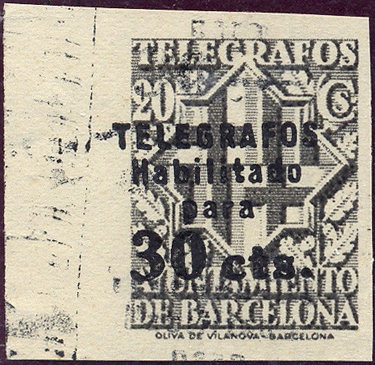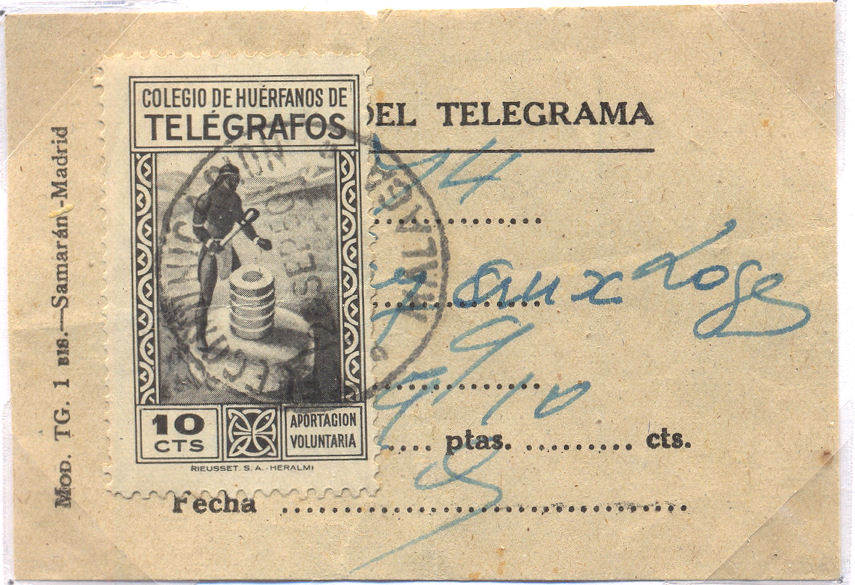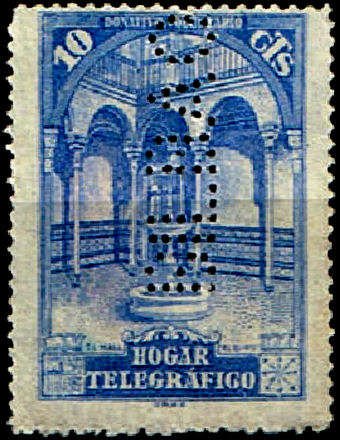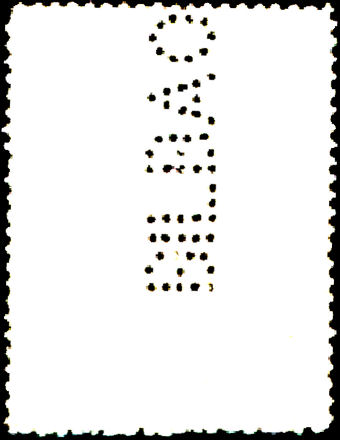| Up a level | ||||||||||
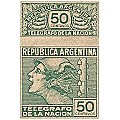 |
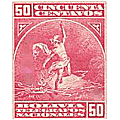 |
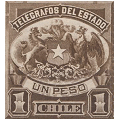 |
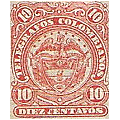 |
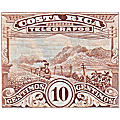 |
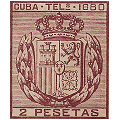 |
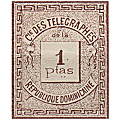 |
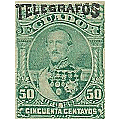 |
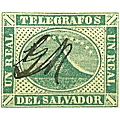 |
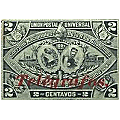 |
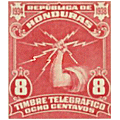 |
| Argentina | Bolivia | Chile | Colombia | Costa Rica | Cuba | Dominican Rep. | Ecuador | El Salvador | Guatemala | Honduras |
| SPAIN | ||||||||||
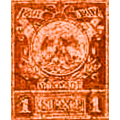 |
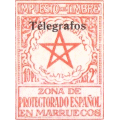 |
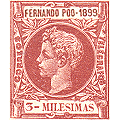 |
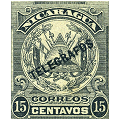 |
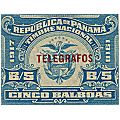 |
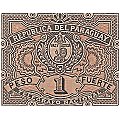 |
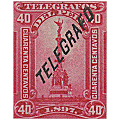 |
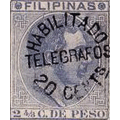 |
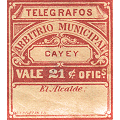 |
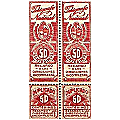 |
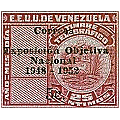 |
| Mexico | Morocco | Guinea | Nicaragua | Panama | Paraguay | Peru | Philippines | Puerto Rico | Uruguay | Venezuela |
| search engine by freefind | advanced |
I have brought these prices up to date and added currency selection. I have had to add a few to the National issues, and have made some additions to the local ones and others. To avoid confusion, I will give these RH numbers (Revised Hiscocks). CheckList Setup |
| Shortcuts to different sections: | ||||||||||
| National | Comunicaciones | War Tax | Cancellations | Local issues | plazas de soberanía | Hoja Telegrafica | Hoja de Reintegro | Huérfanos / Hogar | Telephone stamps | Progress |
SPAIN.
Steve Hiscocks wrote in 1982:
The telegraph stamps of Spain cover a period of some 88 years from 1864 to 1952 — the greatest span of any one issuing authority. Their issue
was not continuous however. In 1870 and until 1878 a series of unified postage and telegraph stamps — the various "Comunicaciones" types — were
issued. From 1879 to 1889 two series specifically inscribed "Correos y Telegs" were issued and from 1889 to 1899 a further series of "Comunicaciones".
These bore the same relationship to telegraph stamps as the 'Postage and Revenue' stamps of, for example, Great Britain and India did to revenue stamps:
that is they were used for telegraphic purposes but were mainly intended for postal use and mainly so used. I have not included these stamps as telegraph
stamps and they may be found listed in any postage stamp catalogue. Their telegraphic use can, however, easily be recognised by the punched cancellations
and their inclusion in collections is of course optional. Otherwise the national telegraph stamps of Spain are quite well behaved. Many of them can also be
found overprinted for use in (Spanish) Morocco (q.v.).
There are numerous charity stamps of Spain which might easily be confused with telegraph stamps in that they bear the words "Huérfanos de Telégrafos" or
"Hogar Telégrafico" meaning 'orphans' and 'home' respectively. These are pure charity stamps intended to raise money for orphans of telegraph workers and,
since their use was optional, they do not fall within my terms of reference. The single stamp of Valencia might be thought to fall within the same category in
that it was intended to raise money for a bridge but in this case its use was compulsory and it is thus analogous of those of Portugal and the federal tax stamps
of the USA. The 'telegraph' stamps of Villada and of Barcelona would seem to fall into the same category.
Background information on the railway telegraph stamps is sparse. A reference of 1893 gives dates of issue (which differ from those usually quoted) and states
that they were for public use but not on sale to the public. Instead the clerk stuck one on the despatch form and another on the receipt or counterfoil —
that is the
sending of a message costing, e.g., one peseta involved the use of two 1 peseta stamps one of which should presumably have then remained with the customer.
My notes:
The yellow highlighted part is perhaps a little disingenuous. It is certainly misleading. Though the low face-value stamps may have been intended and so used,
for postal purposes. It is very likely that, as with other countries (e.g. Britain) when using postage stamps for dual purpose, the higher values were mainly used
for telegraphic purposes (As Hiscocks acknowledged for the Edwardian High values of India). Anyway, I have now added a section for them.
For the pink highlighted part, 1952 may be the official date of cessation for telegraphic use, but they were used until at least 1955 on Hoja de Reintegro which
may have been to pay telephone bills ? — There is also now a Spanish Telephone stamp known.
According to Luis Enrique (PDF, page 17), Spain had been using an optical telegraph network for a long time before the first practical electric telegraph
network began to be created by a decree of 1852, which also set up a school for telegraphy starting with 48 students mostly recruited from former optical telegraph workers.
The first connection was from Madrid to Irún in the north, near the French border. It passed through the provinces of Zaragoza, Navarra and Guipúzcoa.
The telegraph construction was under the control of the Ministry of the Interior until 1857 when it became the responsibility of the Telegraph Corps.
The next connections were to Extremadura on the border with Portugal, and Catalonia in the northeast. These allowed Madrid to connect to its neighbouring countries.
Alsasua, Vitoria and Bilbao were the next to be connected.
Spain — National Telegraph Stamps.
The Galvez catalogue indicates values for punched Telegraph stamps from 1864 to 1869 at 50% of un-punched used prices.
The used prices here are for punched examples. Un-punched used are thus worth a premium. Beware of stamps with incomplete punching or re-filled holes.
1864 (1 July) Typographed on white wove paper. No watermark, Imperf.
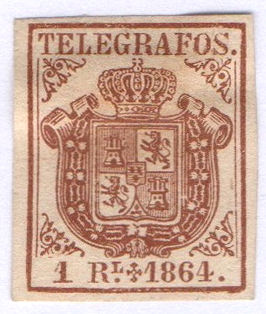 |
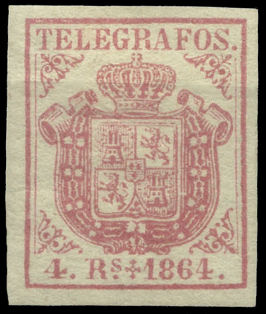 |
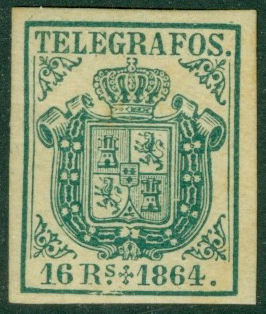 |
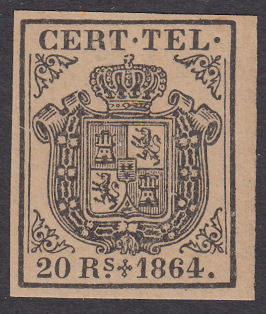 |
| H1 courtesy of Paul & Les Bottomley | H2, 4 Reales | H3 courtesy of Laurens at Dutchstamp | H4, 20 Reales |
| Hisc. | 1864 Description | Mint | Used |
|---|---|---|---|
| H1 | 1r brown | 70.00 | 18.00 |
| H1a | red-brown | 70.00 | 15.00 |
| H2 | 4r rose | 70.00 | 18.00 |
| H2a | pale rose | 70.00 | 15.00 |
| H3 | 16r green | 80.00 | 18.00 |
| H3a | dark green | 80.00 | 15.00 |
| H4 | 20r black | 100.00 | 30.00 |
Hiscocks added the following 2 notes:
| Note 1. Used stamps of 1864 to 1868 or 9 are normally cancelled with a rough punched hole of 3-4mm diameter. |
| Note 2. My copy of Morley's catalogue has a pencilled notation covering Nos. 1-4 (or possibly 1-3) "were rare but 1 sheet of each was found" ! |
My note: I understand that there are 'replicas' of these around.
Anyone know how to recognise them ?
1865 (1 January) Typographed on tinted wove paper. No watermark, Imperf.
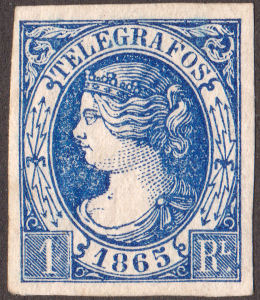
|
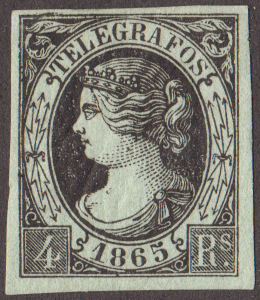
|
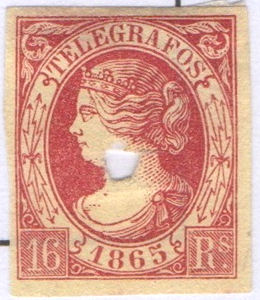 |
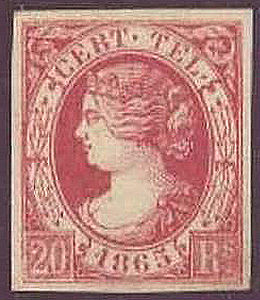
|
| 1r - H5 | 4r - H6 | 16r - H7 | 20r - H8 |
| A couple of mine. | H7 courtesy of Les Bottomley. | H8 courtesy of Gerardo de Villegas (Gdev02 on delcampe, click for listing). |
|
| Hisc. | 1865 Description | Mint | Used |
|---|---|---|---|
| H5 | 1r blue/rose | 90.00 | 15.00 |
| H5a | dark blue/rose | 110.00 | 18.00 |
| H6 | 4r black/green | 100.00 | 15.00 |
| H7 | 16r carmine/yellow | 250.00 | 35.00 |
| H8 | 20r rose/pale rose | 400.00 | 35.00 |
1865 (1 September) As above but on white paper and Perf. 14
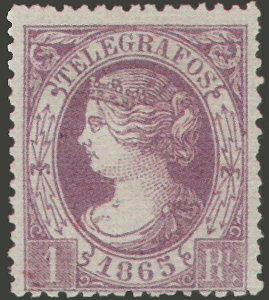 |
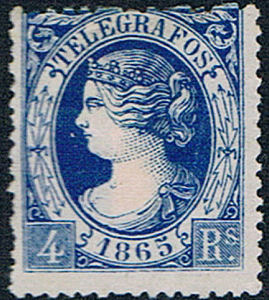 |
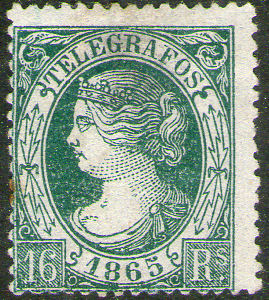 |
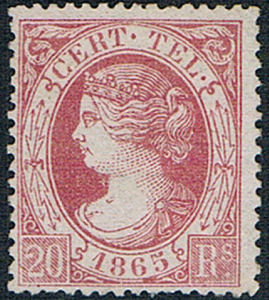 |
| 1Rs - H9 | 4Rs - H10 | 16Rs - H11 | 20Rs - H12 |
| H9 from Les Bottomley, H10 and H12 are courtesy of egv auction (on eBay). H11 is mine. | |||
| Hisc. | 1865 Description | Mint | Used |
|---|---|---|---|
| H9 | 1r violet | 120.00 | 12.00 |
| H9a | deep violet | 150.00 | 15.00 |
| H10 | 4r blue | 120.00 | 12.00 |
| H10a | imperf. | 180.00 | - |
| H10b | imperf. between horizontal pair | 320.00 | - |
| H10c | dark blue | 150.00 | 15.00 |
| H11 | 16r green | 150.00 | 15.00 |
| H11a | yellow green | 160.00 | 16.00 |
| H12 | 20r rose | 250.00 | 25.00 |
| H12a | rose-carmine | 250.00 | 25.00 |
1866 (1 January) As above but dated 1866.
New currency — 100cents = 1 Escudo.
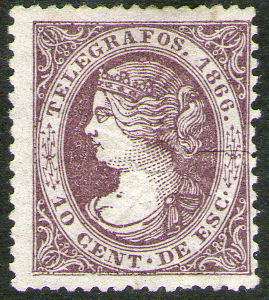 |
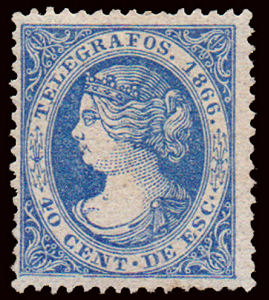 |
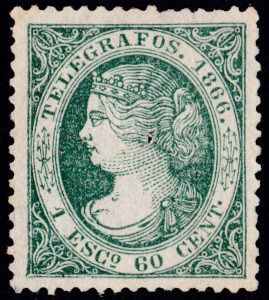 |
 |
| 10c - H13 | 40c - H14, courtesy of egv auction on eBay (click for listing). |
1E60c - H15 | 2E - H16 |
Note the (unsuccessful) closed punch cancel on H13 and H15 above. These are often described as mint, be careful.
The Galvez catalogue prices stamps like this approximately twice the value of the punched stamp without the part still attached.
| Hisc. | 1866 Description | Mint | Used |
|---|---|---|---|
| H13 | 10c deep rose lilac (shades) | 60.00 | 5.00 |
| H14 | 40c blue | 60.00 | 5.00 |
| H14a | darker blue | 80.00 | 6.00 |
| H15 | 1.60 E green | 120.00 | 5.00 |
| H15a | yellow green | 140.00 | 6.00 |
| H16 | 2E rose | 300.00 | 25.00 |
| H16a | deep rose | 300.00 | 30.00 |
1867 (1 January) As above but dated 1867.
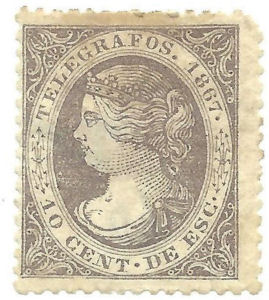 |
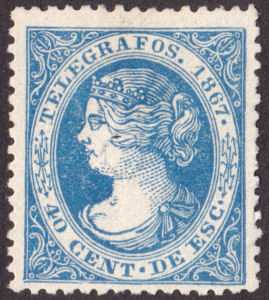 |
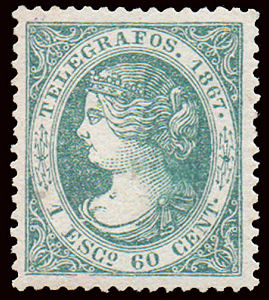 |
| 10c - H17, courtesy of jtwvrm on eBay (click for listing). |
40c - H18 Note the filled punch-hole. |
1.60E - H19, courtesy of egv auction on eBay. |
| Hisc. | 1867 Description | Mint | Used |
|---|---|---|---|
| H17 | 10c grey-lilac (shades) | 50.00 | 5.00 |
| H18 | 40c blue | 40.00 | 5.00 |
| H18a | darker blue | 40.00 | 5.00 |
| H19 | 1.60 E green | 80.00 | 5.00 |
| H19a | yellow green | 80.00 | 5.00 |
| H20 | 2E rose | 200.00 | 18.00 |
| H20a | deeper rose | 200.00 | 18.00 |
1868 (1 January) As above but dated 1868.
New currency — 1000 mils = 1 Escudo.
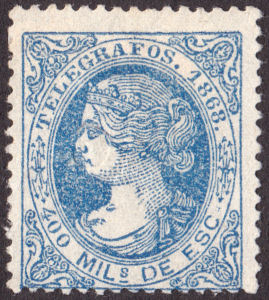 |
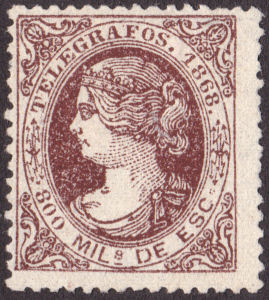 |
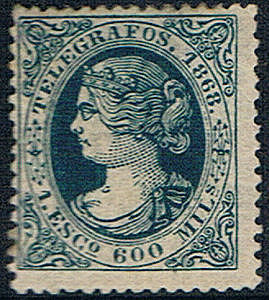 |
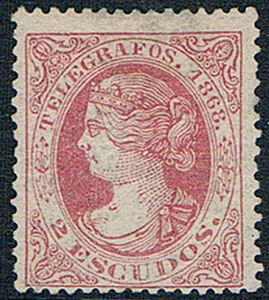 |
| 1868, 400m - H22. | 1868, 800m - H23. | 1868, 1.600E - H24. | 1868, 2E - H25. |
| A couple of mine, both with filled punch-holes. | Images courtesy of egv auction on eBay. | ||
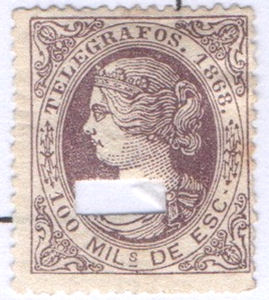 |
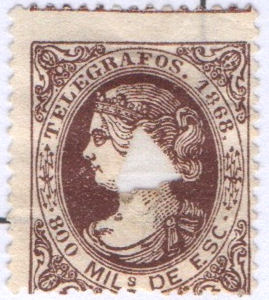 |
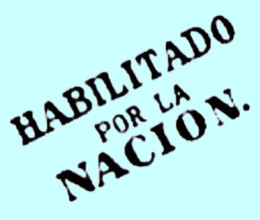 |
| 1868, 400m - H21 with rectangular punch. | 1868, 800m - H23 with triangular punch. | According to M. Galvez, as with Cuba, 400m and 800m were overprinted as above. |
| A couple from Les Bottomley showing different punch-holes. | ||
I have not seen any with the "Habilitado Por La Nacion" overprints, but then I haven't for Cuba either.
Since Galvez was an authority on Spanish stamps, I will list them and appeal for images. Anyone know what the Edifil catalogue says ?
| RH # | Hisc. | 1868 Description | Mint | Used |
|---|---|---|---|---|
| RH21 | H21 | 100m dull purple(shades) | 60.00 | 8.00 |
| RH22 | H22 | 400m blue | 60.00 | 5.00 |
| RH22a | H22a | darker blue | 60.00 | 5.00 |
| RH22b | - | with Habilitado overprint | - | - |
| RH23 | H23 | 800m reddish brown | 60.00 | 5.00 |
| RH23a | H23a | dark reddish brown | 60.00 | 5.00 |
| RH23b | - | with Habilitado overprint | - | - |
| RH24 | H24 | 1.600E myrtle green | 80.00 | 5.00 |
| RH24a | H24a | yellow green | 80.00 | 5.00 |
| RH25 | H25 | 2E rose | 150.00 | 15.00 |
| RH25a | H25a | deep rose | 150.00 | 15.00 |
1869 (1 January) As above but dated 1869. (new colours)
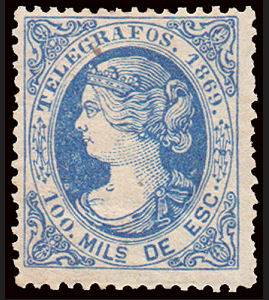 |
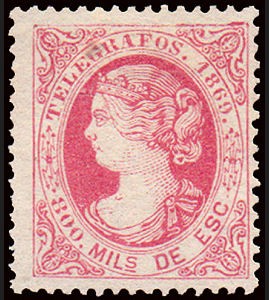 |
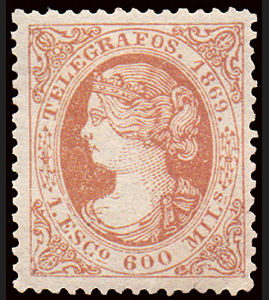 |
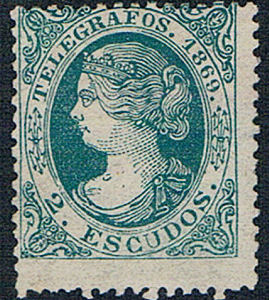 |
| 1869, 100m - H26. | 1869, 800m - H27. | 1869, 1.600E - H28. | 1869, 2E - H29. |
| Images courtesy of egv auction on eBay. | |||
| Hisc. | 1869 Description | Mint | Used |
|---|---|---|---|
| H26 | 100m blue | 40.00 | 5.00 |
| H26a | pale blue | 50.00 | 5.00 |
| H27 | 800m rose | 50.00 | 5.00 |
| H27a | rose-carmine | 60.00 | 5.00 |
| H28 | 1.600E yellow brown | 50.00 | 5.00 |
| H28a | orange-brown | 60.00 | 5.00 |
| H29 | 2E green | 300.00 | 18.00 |
| H29a | dark green | 300.00 | 20.00 |
1869 New design (arms) dated 1869. Other details as above.
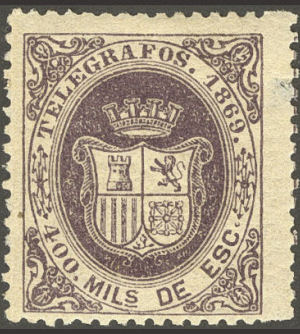 |
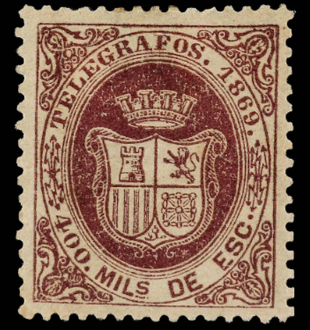 |
| Spain H30 | Spain RH30a courtesy of Soleryllach.com. |
The stamp on the right was described by the vendor as "castaño lila" and came with a certificate describing it as the 1869 violet issue (Edifil no. 30), with an image even less violet.
To me, lumping together such disparate shades is a bit of a stretch, so I have added RH30a.
| RH # | Hisc. | 1869 Description | Mint | Used |
|---|---|---|---|---|
| RH30 | H30 | 400m violet (shades) | 110.00 | 6.00 |
| RH30a | - | brown lilac (shades) | 125.00 | 7.00 |
COMUNICACIONES
Hiscocks added the following note on page 267:
| Note. Following this issue postage stamps were used for telegraphic purposes until 1901. Their telegraphic use is recognised by punched cancellations. |
My note: These stamps were inscribed "COMUNICACIONES" to indicate that they were valid for both postal and telegraphic communications.
This was changed to "CORREOS Y TELGRAFOS" (Posts & Telegraphs) for the 1879-89 issues, possibly to prevent their use to pay for telephone calls ?
The use of punches appears to have been phased out as the cost of telegraphy dropped and potential re-use was less of a problem.
I have put some tentative prices in, but these are derived from postally used prices in US$ as of 2007. Telegraphically used will be much less, but this might give relative scarcity.
There is a Spanish catalogue by Manuel Gálvez Rodríguez (Catálogo : pruebas y ensayos de España 1960) that gave prices for punched stamps. It would be more appropriate for this.
If anyone has a copy and can provide this information, I will happily update the prices and include them in this listing.
|
My notes: 1) Even though stamps for specifically telegraphic use were again available in 1901, this last type of stamp, though not inscribed "COMUNICACIONES" were still apparently being telegraphically used until at least 1905. 2) I have obtained a 1951 copy of the Galvez Catalogue and have used it to estimate current values for telegraphically used stamps. 3) The Scott catalogue does not list the 20c orange Type 13 listed by Galvez(1951) as issued in 1899. Nor does the Michel Catalogue. The Galvez catalogue does not list the 1p carmine-rose (C117) listed by Scott, but it does list a 10p dark red. |
For the specialist, Type 7 shown above exists in 3 variations of the value tablet at the bottom.
Galvez provides a hand-drawn illustration of these, but it leaves a bit to be desired. I can now provide an 1800dpi updated illustration:
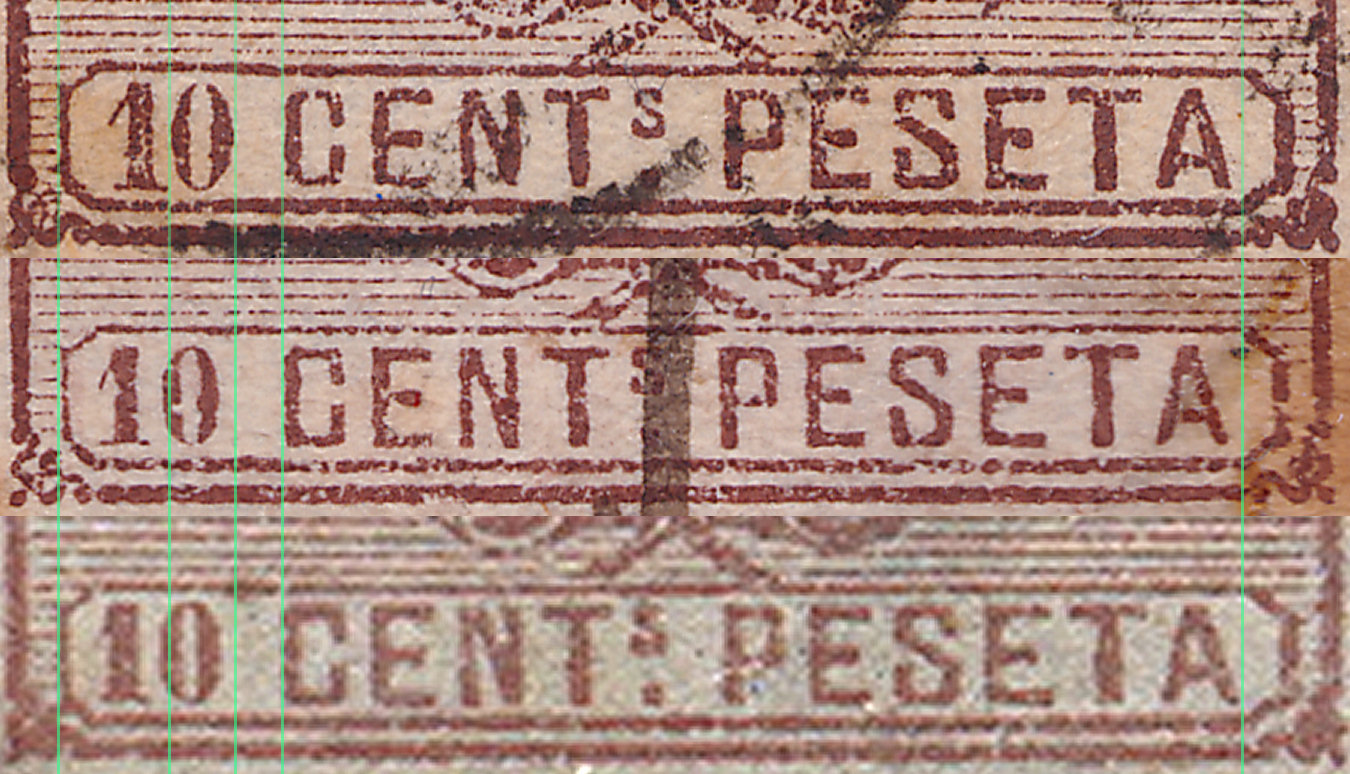
This has Galvez type I at the top and type III at the bottom. The top two are mine and were scanned together. The middle is from Rolf Lamprecht and was originally at 300dpi.
I have added vertical green lines to show relative alignments.
Galvez described the differences as follows:
The last 2 columns are his prices in 1951 Pesetas for mint and used. He does not list any of these as being punched, but prices type II as 1.00 with remainder cancel (see below).
His description of type I "unidas", does not match the stamp, though it does match his illustration of it.
Type III has "10" closest together. It makes me wonder whether perhaps his illustrations were made, rather poorly
(though better than I could do by hand), by someone else and he was simply describing those illustrations.
My identification of the top image as type I is guided by the fact that it is the most common type.
He lists only type I as existing imperforate, pricing it at 1,000.00 mint and 1,500.00 used (clearly not punched).
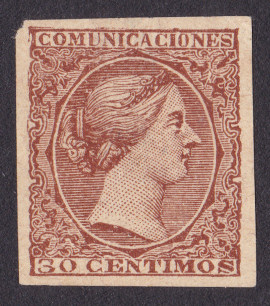
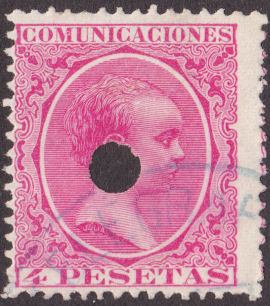
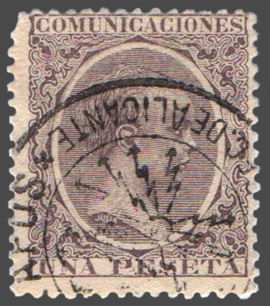
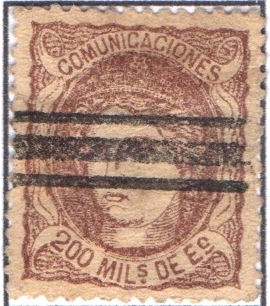
King Alfonso XII died before his son was born. His son was therefore King from birth and his mother Maria Christina Henriette Desideria Felicitas Raineria (of Austria),
the Queen of Spain was regent from the death of her husband until 1902 when her son took over at 16. There are proofs with her head and a similar frame to Type 13.
I have seen them in 8 different colours, also matching colours of Type 13. All have the value 30c. My example seems strangely small and I am not sure if it is genuine.
The last is known as a bar cancel. There is a similar one with two thin lines. These are not telegraphic, they are remainders found on stamps from 1854 to 1882.
So what of these ?
Why would a remaindered stamp have a telegraphic punch cancel ?
The only reason I can think of is that either the cancel or the punch hole is fake.
I don't see how punching a hole in a stamp can increase its value, though I suppose that if you want to collect the whole set telegraphically used,
sacrificing a stamp with little value to create a space-filler may appeal to some, or may create a saleable commodity to those that do not recognize the remaindered cancel.
I would think that all values of these sets would see some telegraphic use, at least in times of shortage of the denominations more commonly used in telegraphy,
but some may be rare telegraphically used. Galvez does not price C9 punched. He also does not price C48 remaindered. The holes look more genuine than the bars.
Images courtesy of Rolf Lamprecht.
WAR TAX
War Tax was levied on an obligatory basis on mail and telegrams during the wars of 1874-6 and 1898-1900.
At least some of these have the familiar punch holes, but not all, particularly in the second period.
My 1951 Galvez catalogue does not list prices for punches war-tax stamps, but does list prices for fiscally used
Anyone have a later Galvez Catalogue? For now, I will use the fiscal pricing as a guide to telegraphic usage.
Other values and colours are known of the 'numeral' stamps of 1897-99
For "1897 A 1898" Michel says that there are values of 30-90c in blue-green and 1-10p in rose - I have most of the greens and the 1p rose.
Also they list for the "1898 - 99." series 30-90c in black and 1-40p in blue - I have seen 30c, 40c, 50c, 60c, 70c, 90c, 1p, 1p20c, 1p80c, 2p, 2p50c, 3p50c, 5p and 10p.
They do not list these as they say that they were not for postal use. I do not know if they were all for fiscal use, or if some had telegraphic use.
More information is needed.
1901 Lithographed on white wove paper. No watermark. Perf. 14
Control number in blue on reverse of stamp. Currency — 100 centavos = 1 peseta.
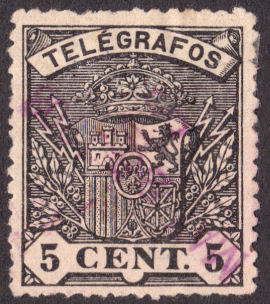 |
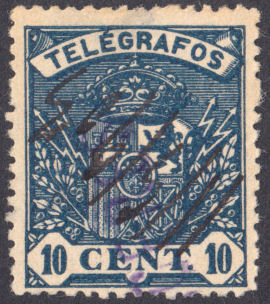 |
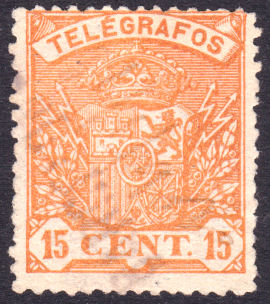 |
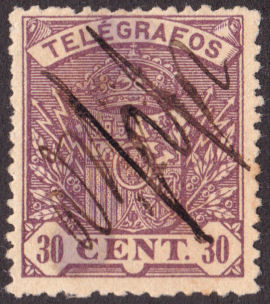 |
| H31 | H32 | H33 | H34 |
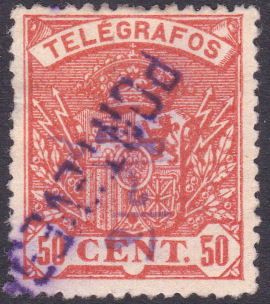 |
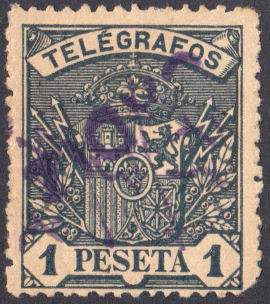 |
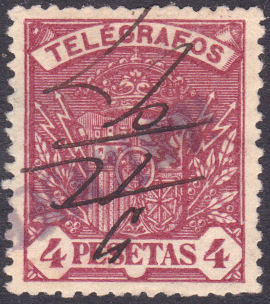 |
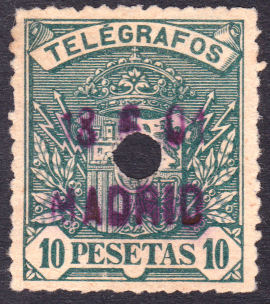 |
| H35 | H36 | H37 | H38 (punched) |
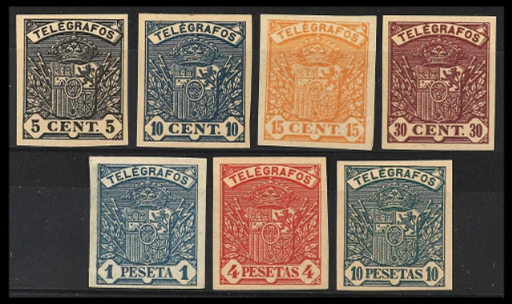 |
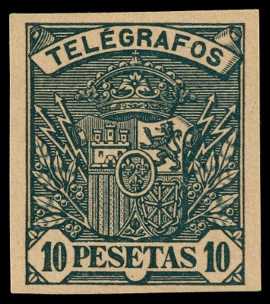 |
| The set of imperfs, less 50c for sale at € 150 in November 2021. Some of the colours are a bit different to the used examples above, notably the 4 peseta. Perhaps these were colour trials. Courtesy of Soleryllach.com |
|
| Hisc. | 1901 Description | Mint | Used |
|---|---|---|---|
| H31 | 5c grey-black | 4.00 | 1.00 |
| H31a | imperf. | 8.00 | - |
| H31b | without controls. | 30.00 | - |
| H32 | 10c Prussian blue | 4.00 | 1.00 |
| H32a | imperf. | 8.00 | - |
| H32b | without controls. | 35.00 | - |
| H33 | 15c orange | 5.00 | 3.00 |
| H33a | imperf. | 10.00 | - |
| H33b | without controls. | 40.00 | - |
| H34 | 30c grey violet | 7.50 | 2.20 |
| H34a | imperf. | 10.00 | - |
| H34b | without controls. | 45.00 | - |
| H35 | 50c red orange | 7.50 | 2.50 |
| H35a | without controls. | 50.00 | - |
| H36 | 1p deep blue grey | 10.00 | 1.50 |
| H36a | imperf. | 15.00 | - |
| H36b | without controls. | 70.00 | - |
| H37 | 4p carmine | 30.00 | 2.50 |
| H37a | imperf. | 35.00 | - |
| H37b | without controls. | 80.00 | - |
| H38 | 10p dark green | 40.00 | 3.00 |
| H38a | imperf. | 50.00 | - |
| H38b | without controls. | 100.00 | - |
Hiscocks added the following 3 notes:
| Note 1. Control numbers are typically of 6 figures starting with '0' (apparently a numeral rather than letter). The ink used was not fast and, on used copies, the control number is often faint and sometimes difficult to detect at all. Missing controls are thus not priced in used condition. |
| Note 2. The use of punched cancellations ceased before 1901 and this and subsequent issues were cancelled with (usually) a line of handstamped type, often smudged, in black or purple together with, in many cases, a pen cancellation — usually the date. |
| Note 3. The 50c value (No. 35) has been implicitly reported imperf. in that the whole set is priced in that state, but the most authoritative source (in my view) excludes this value imperf. |
The used stamps above show that Hiscocks note 2 is not entirely correct.
1905 New design (Alfonso XIII). White wove paper. No watermark. Perf. 14
Control number in blue on reverse of stamp.
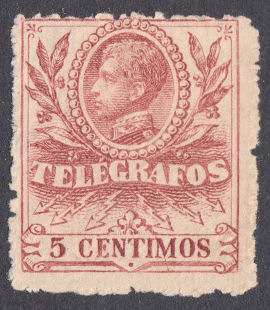 |
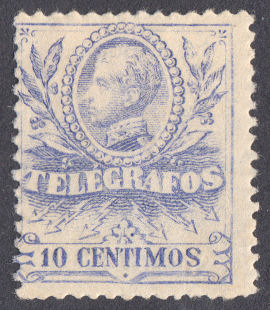 |
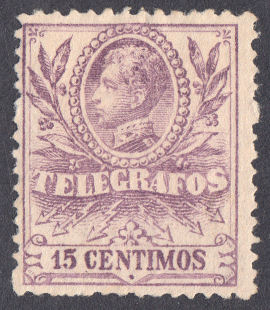 |
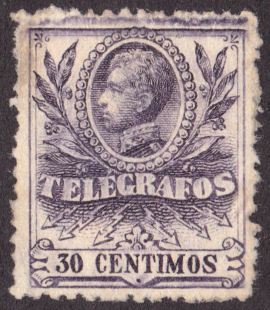 |
| H39 | H40 | H41 | H42 |
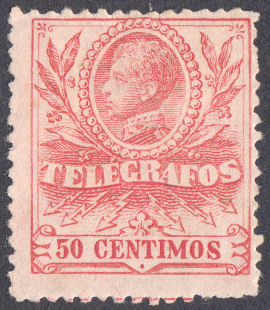 |
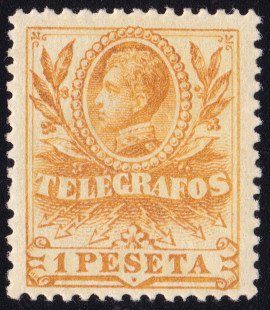 |
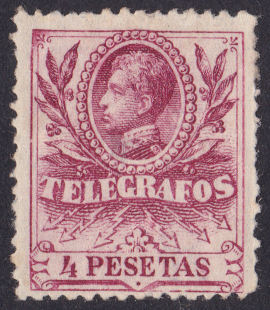 |
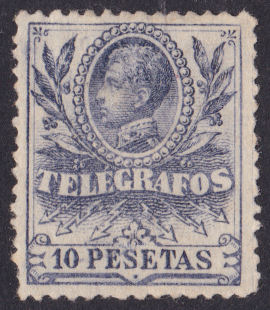 |
| H43 | H44b ? | H45 | H46 |
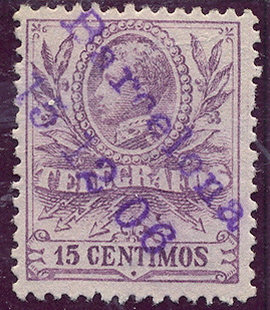 |
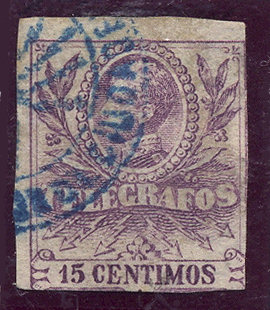 |
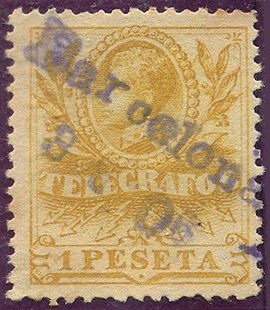 |
| H41, H41a and H44 used courtesy of Rolf Lamprecht. | ||
| Hisc. | Description | Mint | Used |
|---|---|---|---|
| H39 | 5c venetian red | 7.00 | 2.00 |
| H39a | imperf. | 14.00 | - |
| H40 | 10c ultramarine | 7.00 | 2.00 |
| H40a | imperf. | 14.00 | - |
| H41 | 15c deep purple | 8.00 | 2.50 |
| H41a | imperf. | 16.00 | - |
| H42 | 30c deep mauve | 9.00 | 2.50 |
| H42a | imperf. | 18.00 | - |
| H43 | 50c red | 10.00 | 3.00 |
| H43a | imperf. | 20.00 | - |
| H44 | 1p yellow | 20.00 | 6.00 |
| H44a | imperf. | 25.00 | - |
| H44b | brownish yellow | 25.00 | 7.00 |
| H45 | 4p lake | 60.00 | 10.00 |
| H45a | imperf. | 60.00 | - |
| H46 | 10p deep violet blue | 80.00 | 15.00 |
| H46a | imperf. | 70.00 | - |
| H46b | violet | 80.00 | 15.00 |
| Note. Several different forgeries are known of Nos. 44, 46 and 46(a). No. 44(b) was issued in Barcelona to combat a local forgery of No. 44. |
1912 New design (Alfonso XIII). White wove paper (tendency to toning). No watermark. Perf. 12¾ to 14 (mixed)
Control number in blue on reverse preceded by large letter 'A'.
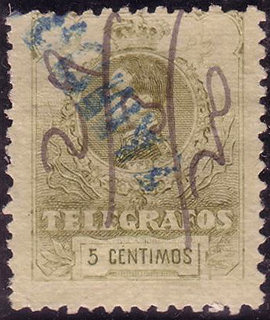 |
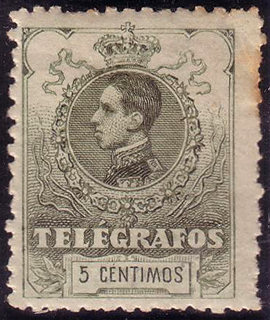 |
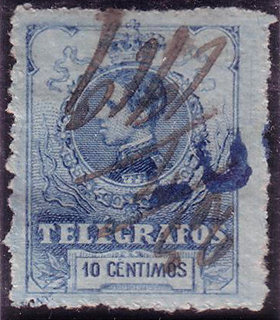 |
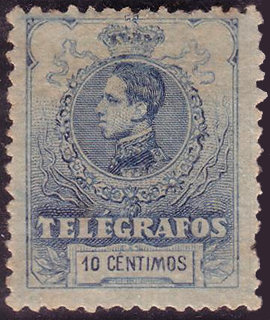 |
| H47 - courtesy of Rolf Lamprecht | H47c - courtesy of Rolf Lamprecht | H48 - courtesy of Rolf Lamprecht | H48b - courtesy of Rolf Lamprecht |
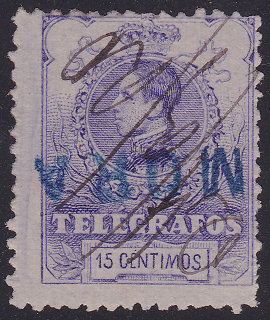 |
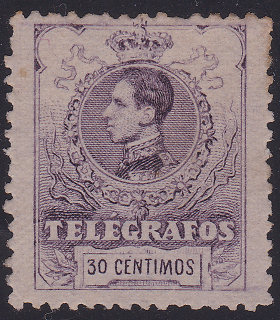 |
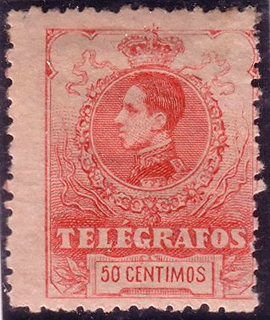 |
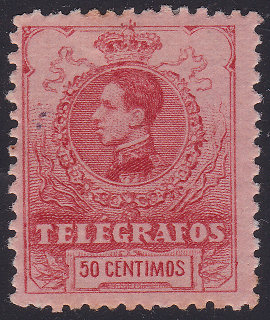 |
| H49 | H50 | H51 - courtesy of Rolf Lamprecht | H51b |
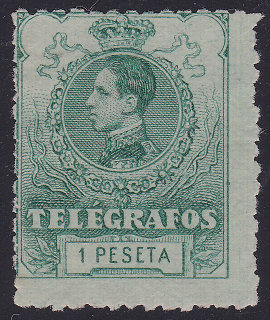 |
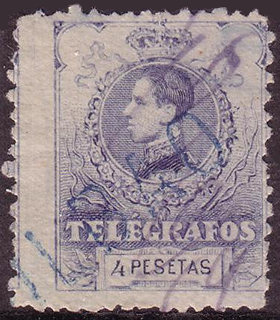 |
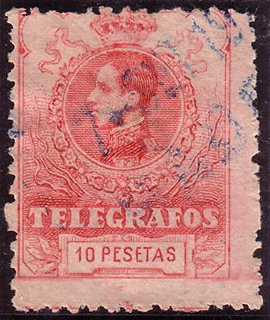 |
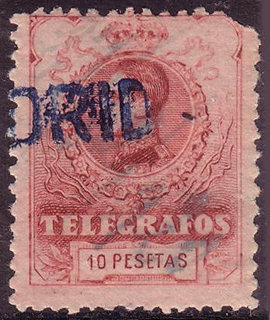 |
| H52 | H53 - courtesy of Rolf Lamprecht | H54 - courtesy of Rolf Lamprecht | H54b - courtesy of Rolf Lamprecht |
| Hisc. | Description | Mint | Used |
|---|---|---|---|
| H47 | 5c olive-green | 3.00 | 0.80 |
| H47a | imperf. | 6.00 | - |
| H47b | light olive | 3.75 | 1.00 |
| H47c | bronze-green | 6.00 | 1.60 |
| H48 | 10c deep dull blue | 3.00 | 0.80 |
| H48a | imperf. | 6.00 | - |
| H48b | deep blue | 4.50 | 1.20 |
| H49 | 15c deep lavender | 3.00 | 0.80 |
| H49a | imperf. | 6.00 | - |
| H50 | 30c lilac | 3.00 | 1.00 |
| H50a | imperf. | 6.00 | - |
| H50b | grey-violet | 3.75 | 1.20 |
| H51 | 50c deep rose red | 3.00 | 1.20 |
| H51a | imperf. | 4.00 | - |
| H51b | carmine | 3.75 | 1.50 |
| H52 | 1p deep grey green | 10.00 | 1.00 |
| H52a | imperf. | 15.00 | - |
| H52b | deep green | 12.50 | 1.25 |
| H53 | 4p dull violet-blue | 25.00 | 3.50 |
| H53a | imperf. | 35.00 | - |
| H54 | 10p rose-carmine | 40.00 | 8.00 |
| H54a | imperf. | 60.00 | - |
| H54b | deep carmine | 80.00 | 16.00 |
Hiscocks added the following note:
| Note. Perforations vary within the range given. Further research is required to determine the varieties corresponding to each value. |
1921 Design as 1901 in different colours. White wove paper. No watermark. Perf. 13½ x 12¾
Control number in blue on reverse preceded by letter 'A'.
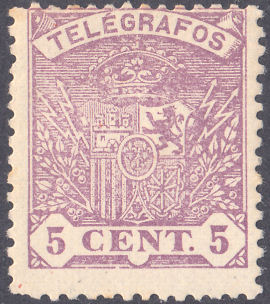 |
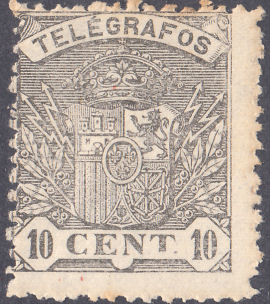 |
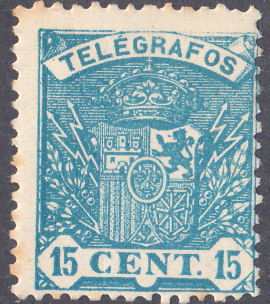 |
| H55 | H56 | H57b |
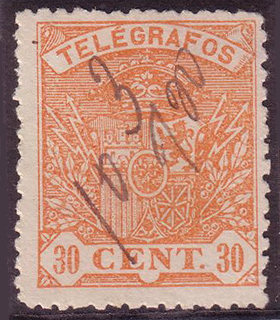 |
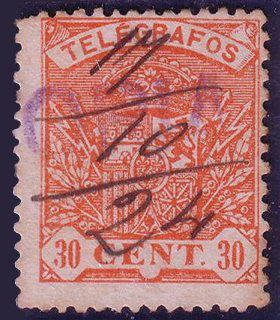 |
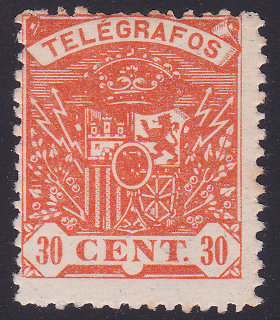 |
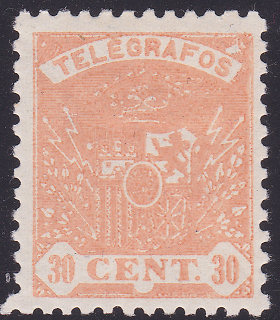 |
| RH58 used (1920 ?) courtesy of Rolf Lamprecht |
RH58b used (1924) courtesy of Rolf Lamprecht |
RH58b | *RH58d |
* I have added RH58d due to the example shown and the fact it is listed in the Galvez catalogue (#86).
Galvez described it as being from a worn plate. He described the other Perf.
11½ x 11¼ stamps as being on glossy paper.
 |
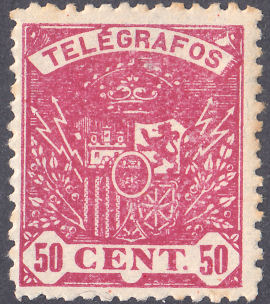 |
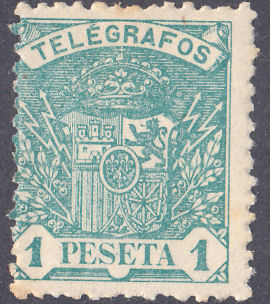 |
| H59 courtesy of Rolf Lamprecht |
H59b | H60 |
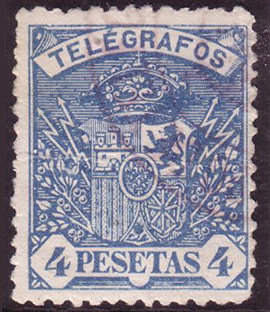 |
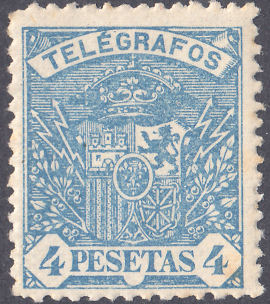 |
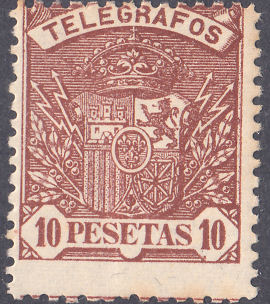 |
| H61 courtesy of Rolf Lamprecht |
H61b | H62 |
| RH # | Hisc. | Description | Mint | Used |
|---|---|---|---|---|
| RH55 | H55 | 5c rose-lilac | 0.75 | 0.75 |
| RH55a | H55a | pale lilac (perf. 11½ x 11¼) (1930-1) | 0.75 | 0.60 |
| RH55b | H55b | malformed '5' in H55a | 3.00 | 1.50 |
| RH55c | H55c | violet | 0.75 | 0.75 |
| RH56 | H56 | 10c black | 0.75 | 0.75 |
| RH56a | H56a | perf. 11½ x 11¼ (1930-1) | 1.00 | 0.60 |
| RH56b | H56b | intense black | 0.75 | 0.75 |
| RH57 | H57 | 15c greenish blue | 1.50 | 0.75 |
| RH57a | H57a | sky blue (perf. 11½ x 11¼) (1930-1) | 1.75 | 0.75 |
| RH57b | H57b | sky blue (Perf. 13½ x 12¾) | 1.50 | 0.75 |
| RH57c | H57c | imperf. between vertical pair | 12.00 | - |
| RH58 | H58 | 30c pale orange | 2.25 | 0.75 |
| RH58a | H58a | red-orange (perf. 11½ x 11¼) (1930-1) | 2.00 | 0.80 |
| RH58b | H58b | deep orange (Perf. 13½ x 12¾, 1932 ?) | 2.25 | 0.75 |
| RH58c | H58c | imperf. (orange) | 9.00 | - |
| *RH58d | - | yellow-orange (perf. 11½ x 11¼) (1931) | 1.70 | 0.80 |
| RH59 | H59 | 50c deep rose | 2.25 | 1.00 |
| RH59a | H59a | rose-carmine (perf. 11½ x 11¼) (1930-1) | 2.50 | 1.25 |
| RH59b | H59b | deep carmine | 2.25 | 1.00 |
| RH60 | H60 | 1p green | 5.00 | 1.50 |
| RH60a | H60a | light green(perf. 11½ x 11¼) (1930-1) | 5.00 | 1.50 |
| RH60b | H60b | pale green-blue | 5.00 | 1.50 |
| RH60c | H60c | imperf. (green-blue) | 12.50 | - |
| RH61 | H61 | 4p blue | 20.00 | 4.50 |
| RH61a | H61a | pale blue (perf. 11½ x 11¼) (1930-1) | 25.00 | 3.50 |
| RH61b | H61b | pale blue | 22.00 | 5.00 |
| RH62 | H62 | 10p brown | 30.00 | 4.00 |
| RH62a | H62a | light brown (perf. 11½ x 11¼) (1930-1) | 40.00 | 5.00 |
| RH62b | H62b | sepia brown | 35.00 | 6.00 |
1931-33 As above but perf. 11½ x 11¼ and overprinted "República Española" in black or red.
Control numbers as before.
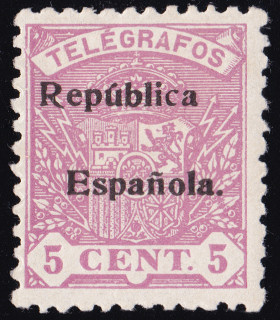 |
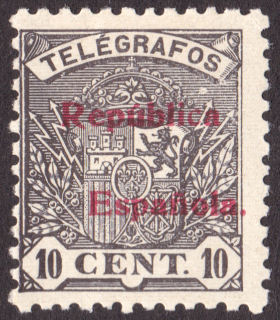 |
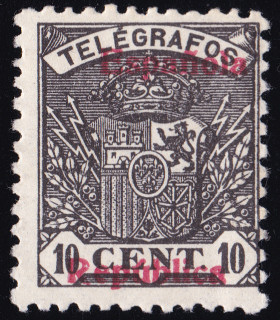 |
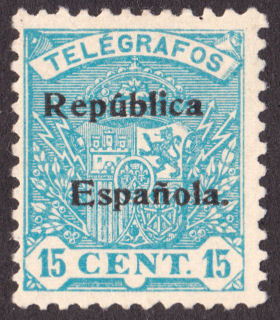 |
| H63 | H64 | H64a ? - I am suspicious of the overprint There is no dot after 'Españiola'. |
H65 |
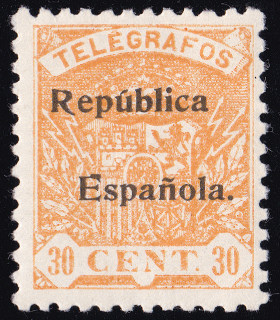 |
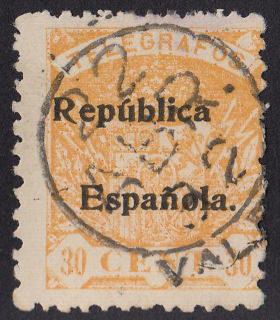 |
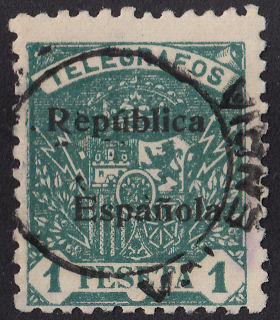 |
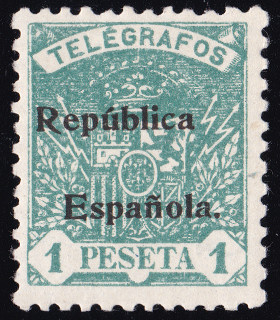 |
| H66 | H67 | ||
| Hisc. | Description | Mint | Used |
|---|---|---|---|
| H63 | 5c lilac (black) | 7.50 | 4.00 |
| H63a | malformed '5' | 15.00 | 10.00 |
| H64 | 10c black (red) | 7.50 | 3.00 |
| H65 | 15c sky blue (black) | 12.50 | 3.00 |
| H66 | 30c orange (black) | 42.00 | 8.00 |
| H67 | 1p green (black) | 80.00 | 8.00 |
| H67a | perf. 14 | 80.00 | 8.00 |
Having bought a mounted mint set of these, sold as genuine for €75, I started looking closely at these after scanning.
Some of them look rather suspicious. According to Filatelia Digital, Spain has the dubious honour of being the first country
in which a stamp was falsified, and has been continuing with this tradition for 150 years.
Generally forgers concentrate on postage stamps, but stamps for telegraphic use can be relatively high denominations.
I know there are forgeries of the 1905 1p and 10p.
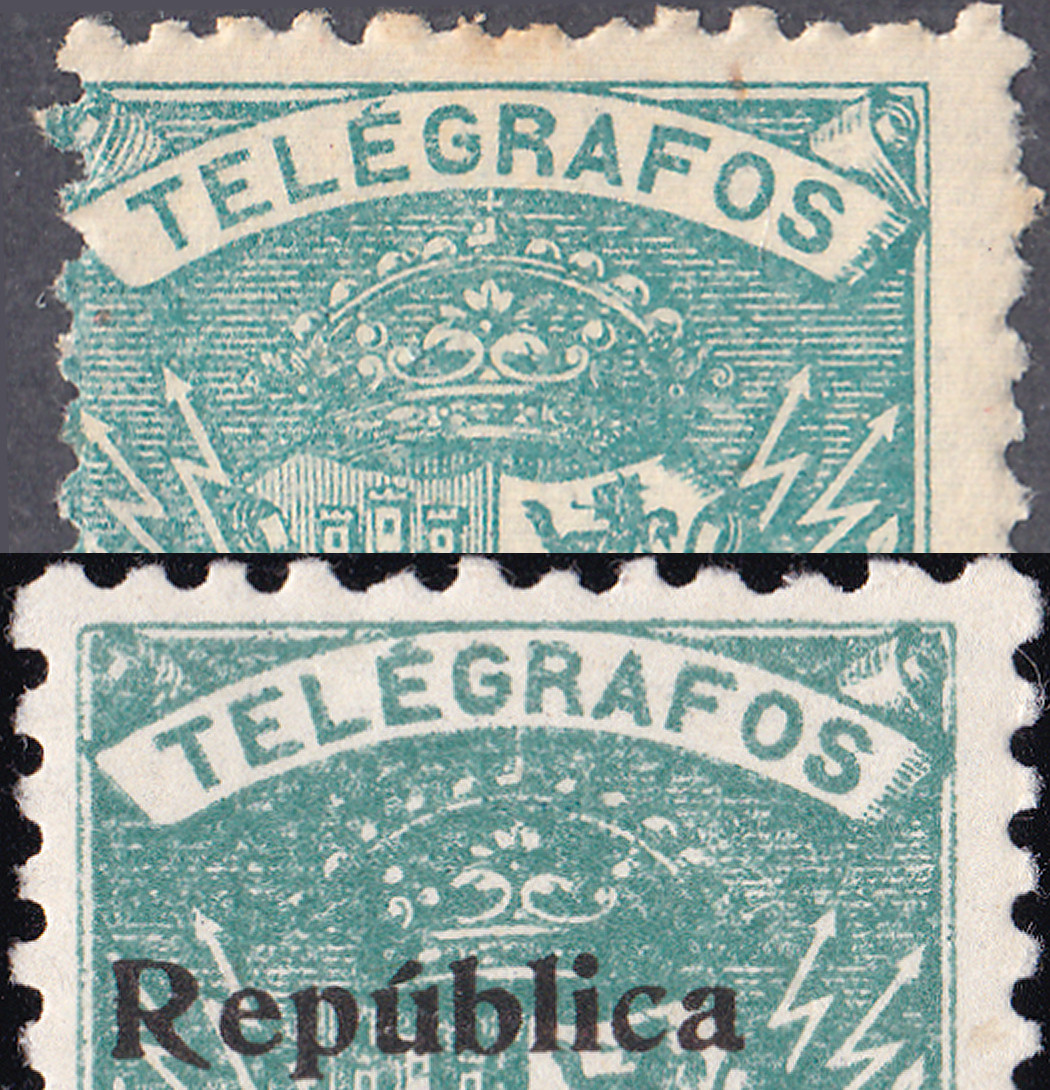
At the top is a 1921 one peseta stamp and at the bottom an overprinted one peseta stamp. Though the overprint looks like it could be genuine,
the actual stamp looks more like a typo example than a litho example. The perforations look reasonable, but the printing looks fuzzy and poor quality.
It seems unlikely though, that there would be a genuine overprint on a fake stamp !
Does anyone have information about fake Spanish Telegraph stamps?
¿Alguien tiene información sobre falsos sellos telegráficos españoles?
1932-36 New design. White wove paper. No watermark. Perf. 11¼
Control number in black on reverse and preceded by large letter 'A'.
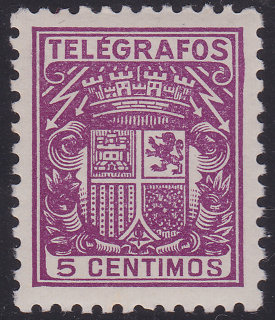 |
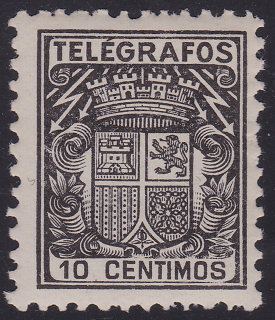 |
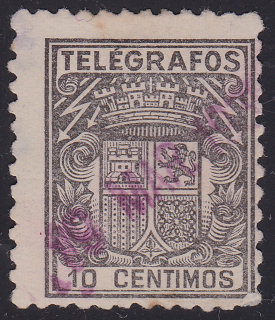 |
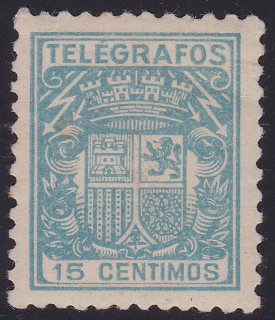 |
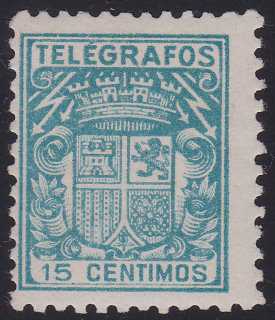 |
| H68 (black A063,952) | H69 (feint black A163,150) | H69 used (feint A082,154) | H70 (black A058,512) | H70b |
| — Scanned together — | ||||
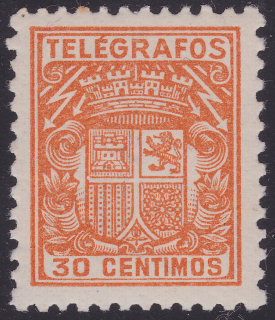 |
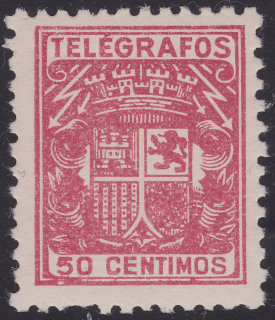 |
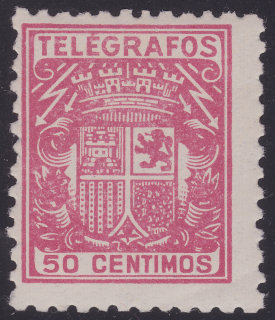 |
| H71 (black A185,585) | H72 (black A138,533) | H72 (feint black A140,715) |
| — Scanned together — | ||
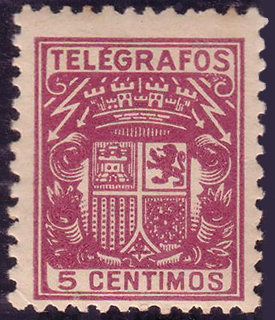 |
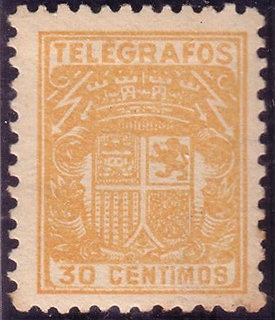 |
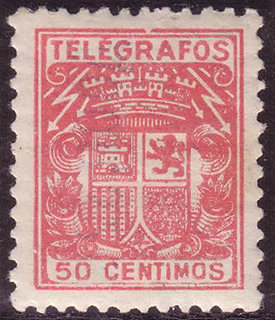 |
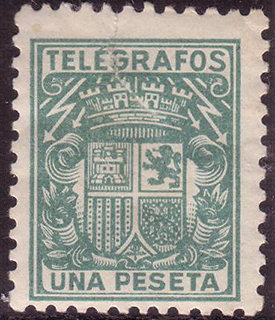 |
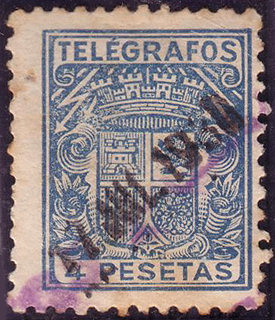 |
| H68a (blue control) | H71a (blue control) | H72a (blue control) | H73a (blue control) | H74 used (black control) |
| — Courtesy of Rolf Lamprecht - scanned together — | ||||
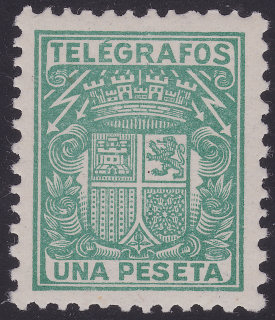 |
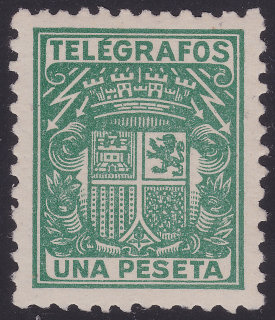 |
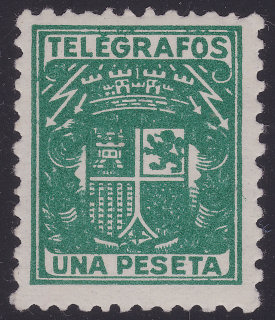 |
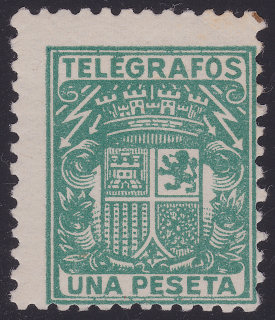 |
| H73 (feint black A264,269) | H73 (black A271,776) | H73 (black A243,798) | H73b |
| — Scanned together — | |||
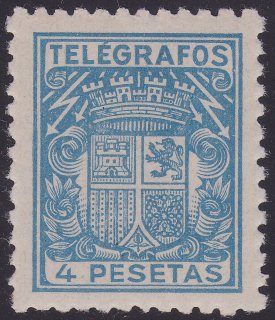 |
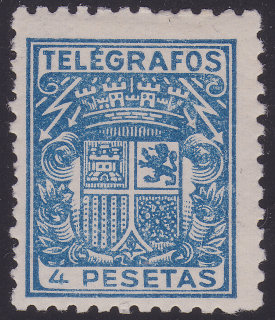 |
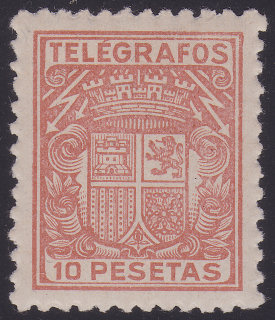 |
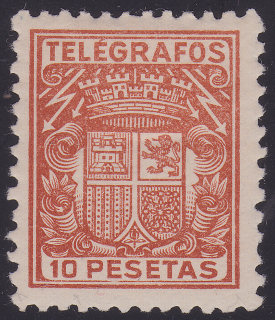 |
| H74 (black A030,511) | H74b | H75 (black A046,178) | H75b |
| — Scanned together — | |||
Though Hiscocks quotes Galvez in many instances, his sequence in this list contradicts him. According to Galvez,
The first issue of 1932 had blue controls on the back, followed in 1933-4 by an issue without controls, then in 1935-6 the issue with black controls.
Anyone have clearly dated examples with blue or black controls ?
1937, 1st anniversary of the National Uprising of 1936. Black controls or none.
This overprint was applied (in Seville) to these 1936 stamps, a number of then-current postage stamps, and an urgent correspondence stamp.
The Galvez Catalogue lists these on page 139 of the 1951 edition. As far as I know it did not affect the value or usage of the stamps.
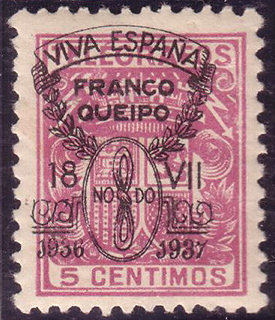 |
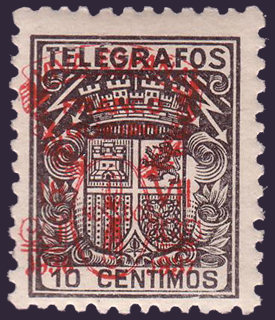 |
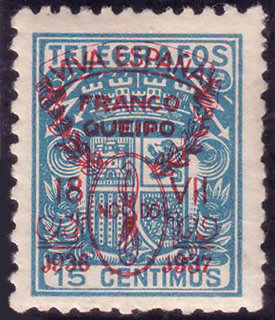 |
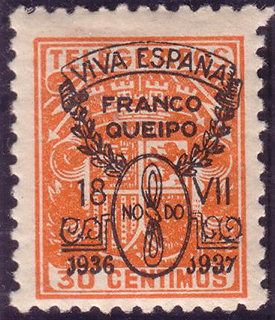 |
| H74 (black A030,511) | H74b | H75 (black A046,178) | H75b |
| — Courtesy of Rolf Lamprecht - scanned together — | |||
| RH # | Hisc. | Description | Mint | Used |
|---|---|---|---|---|
| NU1 | - | 5c reddish purple (no control) | 2.00 | 2.50 |
| NU2 | - | 10c black (red) | 5.00 | 6.00 |
| NU3 | - | 15c sky blue (red, no control) | 5.00 | 6.00 |
| NU4 | - | 30c orange | 6.50 | 8.00 |
1940-42 Lithographed on white wove paper. No watermark. Perf. 11¼ to 11¾
Control number in black on reverse.
  |
| Spain 1940-42 The 5c, 1P and 10P are from the 1949 series, the rest are from the 1940 series. |
| Hisc. | Description | Mint | Used |
|---|---|---|---|
| H76 | 5c bluish grey (shades) (perf. 11¼ x 11¾) | 0.60 | 0.40 |
| H76a | perf. 11½ x 11¾ | 0.60 | 0.40 |
| H77 | 10c lightish brown (shades) (perf. 11¼ x 11¾) | 0.60 | 0.40 |
| H77a | perf. 11½ x 11¾ | 0.60 | 0.40 |
| H78 | 15c rose (shades) (perf. 11¼ x 11¾) | 0.80 | 0.40 |
| H78a | perf. 11½ x 11¾ | 0.80 | 0.40 |
| H78b | perf. 11½ | 1.20 | 0.60 |
| H79 | 30c grey-green (shades) (perf. 11¼ x 11¾) | 0.80 | 0.40 |
| H79a | perf. 11½ x 11¾ | 0.80 | 0.40 |
| H79b | perf. 11½ | 0.80 | 0.40 |
| H80 | 50c ultramarine (perf. 11¼ x 11¾) | 2.00 | 0.60 |
| H80a | perf. 11½ | 2.00 | 0.80 |
| H81 | 50c scarlet (shades) (1942) (perf. 11¼ x 11¾) | 1.00 | 0.40 |
| H81a | perf. 11½ x 11¾ | 1.00 | 0.40 |
| H82 | 1p violet (shades) (perf. 11¼ x 11¾) | 2.50 | 0.40 |
| H82a | perf. 11½ x 11¾ | 2.50 | 0.40 |
| H82b | perf. 11½ | 2.50 | 0.50 |
| H82c | perf. 11¼ x 11½ | 2.50 | 0.40 |
| H83 | 4p chocolate (shades) (perf. 11¼ x 11¾) | 7.75 | 0.40 |
| H83a | perf. 11½ x 11¾ | 7.75 | 0.40 |
| H84 | 10p blue to steel blue (perf. 11¼ x 11¾) | 20.00 | 0.50 |
| H84a | perf. 11½ x 11¾ | 20.00 | 0.50 |
| H84b | perf. 11¼ x 11½ | 20.00 | 0.50 |
Hiscocks added the following 2 notes:
| Note 1. The controls on the reverse can be completely removed by soaking and are thus usually absent in used copies. |
| Note 2. The listing of perforation varieties above is taken from my own very limited collection and is no doubt far from complete. Further information is required. |

30c grey proof or colour trial courtesy of Rolf Lamprecht.
1949 As above but perf. 13½ or 13½ x 13¼.
| Hisc. | Description | Mint | Used |
|---|---|---|---|
| H85 | 5c pale blue-grey | 0.80 | 0.30 |
| H85a | perf. 13½ x 13¼ | 0.80 | 0.30 |
| H86 | 10c lightish brown | 0.80 | 0.30 |
| H86a | perf. 13½ x 13¼ | 0.80 | 0.30 |
| H86b | imperf. | 5.00 | - |
| H87 | 15c rose | 0.80 | 0.30 |
| H87a | perf. 13½ x 13¼ | 0.80 | 0.30 |
| H87b | imperf. | 5.00 | - |
| H88 | 30c grey-green (shades) | 0.80 | 0.30 |
| H88a | perf. 13½ x 13¼ | 0.80 | 0.30 |
| H88b | imperf. | 5.00 | - |
| H89 | 50c scarlet | 1.00 | 0.30 |
| H89a | perf. 13½ x 13¼ | 1.00 | 0.30 |
| H90 | 1p violet | 1.25 | 0.25 |
| H90a | perf. 13½ x 13¼ | 1.25 | 0.25 |
| H90b | imperf. | 5.00 | - |
| H91 | 4p chocolate | 3.00 | 0.40 |
| H91a | perf. 13½ x 13¼ | 3.00 | 0.40 |
| H91b | imperf. | 10.00 | - |
| H92 | 10p blue | 4.50 | 0.50 |
| H92a | perf. 13½ x 13¼ | 4.50 | 0.50 |
| H92b | imperf. | 15.00 | - |
Hiscocks added the following note:
| Note. All of the used copies I have examined have been perf. 13½ and this is how this set has always been catalogued in the past. I do however have a mint set where all values are perf. 13½ x 13¼ and have therefore listed this variety. |
Cancellations.
Fairly ornate telegraphic cancels were used with or without an additional punch hole.
Postal cancels may also be found on telegraph stamps since the wrong cancel was sometimes applied and since telegraph stamps were sometimes accepted for postage.
From 1854 to 1882, bar cancels were applied to remainders. These are typically worth about 10% of postally used examples.
Pen strokes were also used and there are also fake cancellations.
Hiscocks says (page 265): In 1870 and until 1878 a series of unified postage and telegraph stamps - the various "Comunicaciones" types - were issued.
From 1879 to 1889 two series specifically inscribed "Correos y Telegs" were issued and from 1889 to 1899 a further series of "Comunicaciones".
These bore the same relationship to telegraph stamps as the 'Postage and Revenue' stamps of, for example, Great Britain and India did to revenue stamps:
that is, they were used for telegraphic purposes but were mainly intended for postal use and mainly so used.
Hiscocks does not include them for that reason, but I will.
Hiscocks goes on to say: Their telegraphic use can, however, easily be recognised by the punched cancellations and their inclusion in collections is of course optional.
The following images are courtesy of Jeff Turnbull.
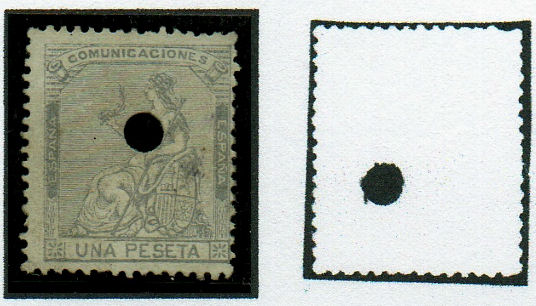
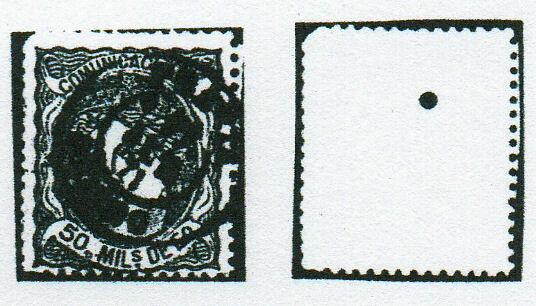
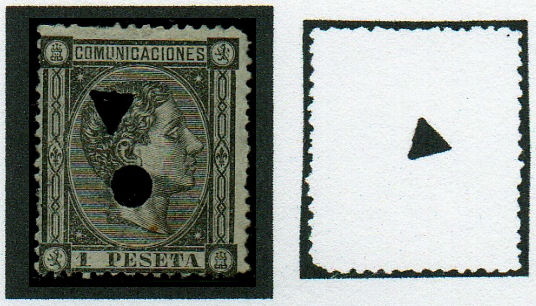
These are the standard type of punched cancels, with the first being by far the most common.
Below are T.1. to T.6. that appear to be telegraphic cancels.
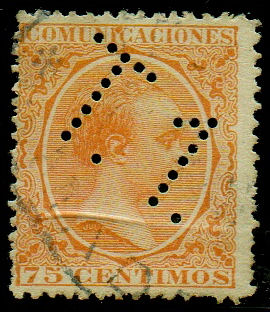 |
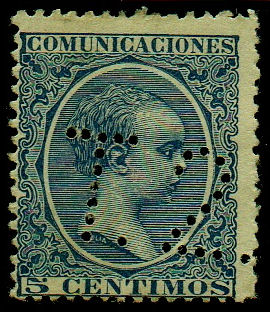 |
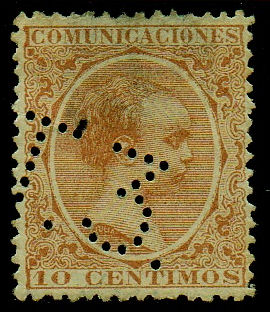 |
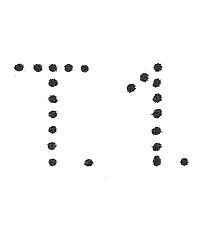 |
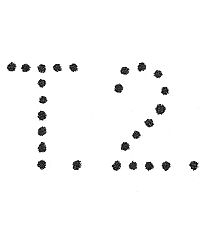 |
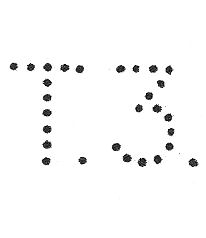 |
 |
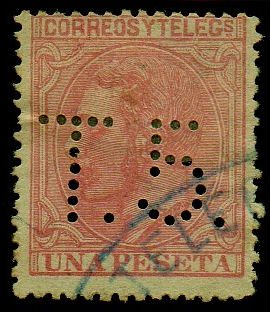 |
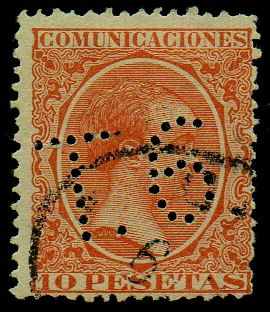 |
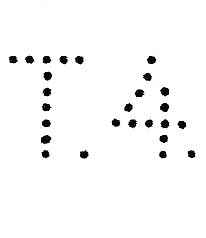 |
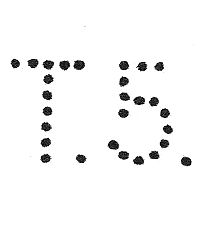 |
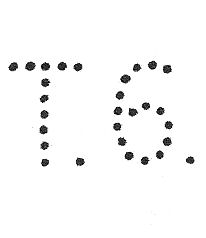 |
These are also known on stamps already perfined with company perfins. In this case 'C.L.' for Credit Lyonnais, Madrid (c 1880s).
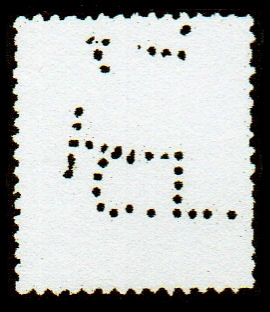 |
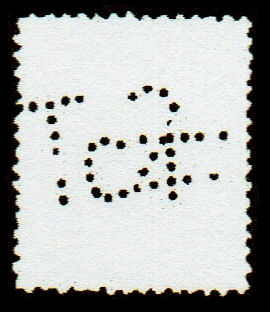 |
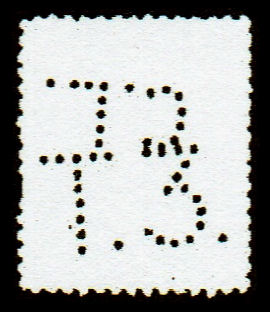 |
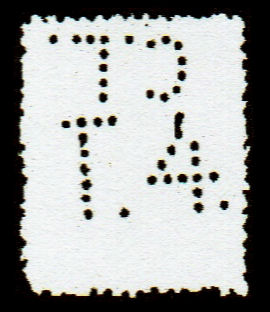 |
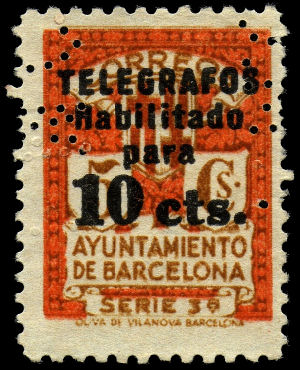  |
| Another private perfin, F.M.C. user unknown, courtesy of Jeff Turnbull. |
Scans of more examples are invited and welcome.
Local issues.
Barcelona
1930 Postage stamps overprinted and surcharged as shown. No watermark. Perf. 11.
Control number in black on reverse. This was an obligatory tax.
| RH # | Hisc. | Description | Mint | Used |
|---|---|---|---|---|
| RH93 | H93 | 10c on 5c red and yellow (ovpt. in black) | 2.00 | 0.50 |
| RH93a | H93a | imperf. | 4.00 | - |
| RH93b | H93b | perf. 14 | 10.00 | 6.00 |
| RH93c | H93c | horizontal pair - imperf. between, perf. 11 | - | - |
| RH93d | H93d | horizontal pair - imperf. between, perf. 14 | - | - |
| RH93e | H93e | horizontal strip of three - imperf. between, perf. 11 | - | - |
| RH93f | H93f | horizontal strip of three - imperf. between, perf. 14 | - | - |
| RH93g | H93g | vertical pair - imperf. between, perf. 11 | - | - |
| RH93h | H93h | vertical pair - imperf. between, perf. 14 | - | - |
| RH94 | H94 | 20c on 5c red and yellow (ovpt. in green) | 15.00 | 1.80 |
| RH94a | H94a | imperf. | 30.00 | - |
| RH94b | H94b | perf. 14 | 12.00 | 8.00 |
| RH94c | H94c | horizontal pair - imperf. between, perf. 11 | - | - |
| RH94d | H94d | horizontal pair - imperf. between, perf. 14 | - | - |
| RH94e | H94e | horizontal strip of three - imperf. between, perf. 11 | - | - |
| RH94f | H94f | horizontal strip of three - imperf. between, perf. 14 | - | - |
| RH94g | H94g | vertical pair - imperf. between, perf. 11 | - | - |
| RH94h | H94h | vertical pair - imperf. between, perf. 14 | - | - |
| RH95 | H95 | 30c on 5c red and yellow (ovpt. in red) | 24.00 | 2.00 |
| RH95a | H95a | imperf. | 48.00 | - |
| RH95b | H95b | without overprint | 30.00 | 27.50 |
| RH95c | H95c | without overprint and imperf. | 48.00 | - |
1934 Postage stamps of 1932-34, overprinted and surcharged as shown. White wove paper, no watermark. Perf. 11.
"Series 3a" Control number in black on reverse.
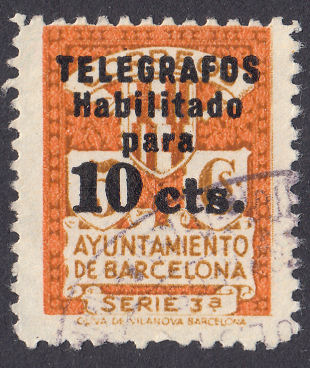 |
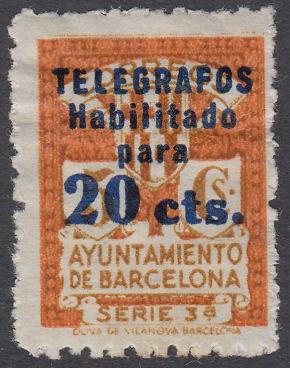 |
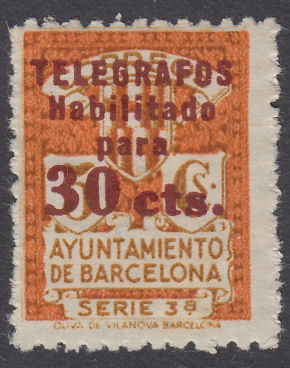 |
| RH96 | RH97 | RH98 |
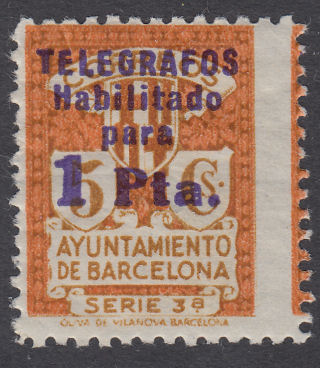 |
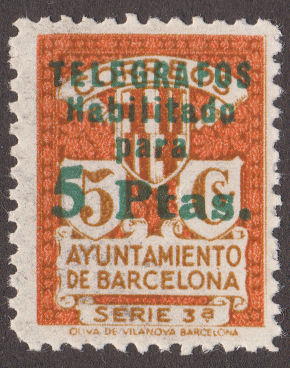 |
| RH99 | RH100 |
1936 Postage stamps of 1936, overprinted and surcharged as before. White wove paper, no watermark. Perf. 16.
"Series 5a - Y " or "Series 5a - Z " in red and control number in black on reverse.
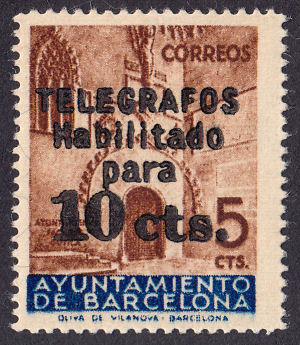
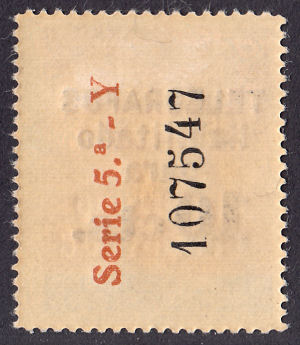
| RH # | Hisc. | Description | Mint | Used |
|---|---|---|---|---|
| RH101 | H101 | 10c on 5c red-brown and blue | 45.00 | 15.00 |
| RH101a | H101a | imperf. | 80.00 | - |
1936 to 1938 As the 1934 series, but "Series 4a", no watermark. Perf. 11.
Control number in black on reverse.
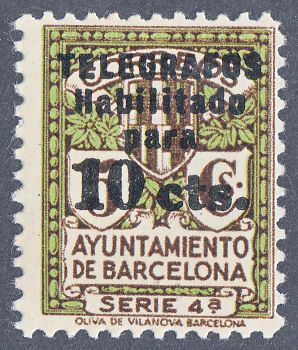 |
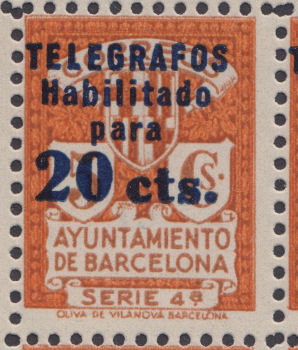 |
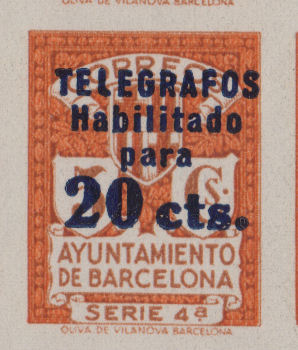 |
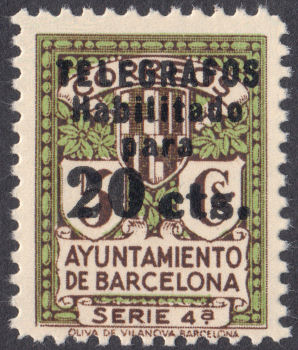 |
| RH102 | RH103 | RH103b | RH104 |
1941 New design. White wove paper, no watermark. Perforations in the range of 9½ to 11½ horizontally and vertically, independently.
Control numbers on reverse.
| Hiscocks Type 19 - RH105 (Perf. 11½) | Hiscocks Type 19 - RH106 (Perf. 11½x9½) | Hiscocks Type 19 - RH106 (Perf. 10¾) |
| Hiscocks Type 19 - RH107 (Perf. 10¾x11½) | Hiscocks Type 19 - RH108 | Hiscocks Type 19 - RH108 (Perf. 11½) |
| RH # | Hisc. | Description | Mint | Used |
|---|---|---|---|---|
| RH105 | H105 | 10c brown | 1.50 | 0.50 |
| RH105a | H105a | imperf. | 8.00 | - |
| RH105b | H105b | perf. 16 | 7.50 | - |
| RH106 | H106 | 20c black | 1.50 | 0.50 |
| RH106a | H106a | imperf. | 8.00 | - |
| RH106b | H106b | perf. 16 | 7.50 | - |
| RH107 | H107 | 30c blue | 2.00 | 0.80 |
| RH107a | H107a | imperf. | 10.00 | - |
| RH108 | H108 | 1p violet | 3.00 | 2.50 |
| RH108a | H108a | imperf. | 15.00 | - |
John Barefoot illustrates a perf.16 stamp(H105b).
The perforations are a bit irregular, it is possible to measure 10½ at the top, but nearer to 11 at the bottom.
1942-1945 Stock Exchange tax stamp and the types above, overprinted in black as shown.
White wove paper, no watermark. H109 is Perf.11, the others as described above. Control numbers on reverse.
| RH # | Hisc. | Type. | Description | Mint | Used |
|---|---|---|---|---|---|
| RH109 | H109 | T20 | 10c on 11.25c violet | 12.00 | 2.50 |
| RH109a | H109a | imperf. | 10.00 | - | |
| ?RH109b | - | imperf. - overprint inverted | - | - | |
| ?RH110 | - | T19A | 10c on 20c black | - | - |
| RH111 | H110 | T19A | 10c on 30c blue | 35.00 | 10.00 |
| RH111a | H110a | imperf. | 63.00 | - | |
| RH111b | H110b | error - overprint in red | 70.00 | - | |
| ?RH111c | - | imperf. error - overprint in red | - | - | |
| ?RH111d | - | imperf. error - overprint inverted | - | - | |
| RH112 | H111 | T19A | 20c on 1p violet | 70.00 | 10.00 |
| RH112a | H111a | imperf. | 100.00 | - | |
| RH113 | H112 | T19A | 30c on 10c brown | 150.00 | 15.00 |
| RH113a | H112a | imperf. | 140.00 | - | |
| RH113b | H112b | Perf. 16 | 100.00 | 10.00 | |
| ?RH113c | - | error - overprint inverted | - | - | |
| ?RH113d | - | error - overprint in red | - | - | |
| ?RH113e | - | imperf. error - overprint in red | - | - | |
| †RH114 | - | T19A | 30c on 20c black | - | - |
| †RH114a | - | imperf. | - | - | |
| ?RH115 | - | T19A | 40c on 20c black - imperf. overprint in red-orange | - | - |
| ?RH116 | - | T19A | 50c on 20c black - imperf. overprint in carmine | - | - |
† These are apparently listed in the Specialised Michel Catalogue as numbers 21 and 21a - see image above.
? These have been added due to items listed on Delcampe by Phildom_domfil. They all have certificates issued by Francisco Graus of Barcelona.
I cannot help wondering about the status of these.
There were other values of Type 20, variously overprinted, but apparently they were not issued.
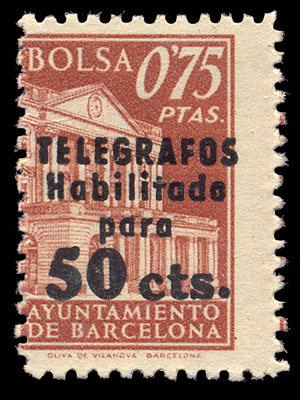
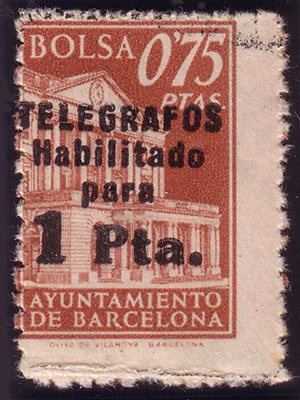
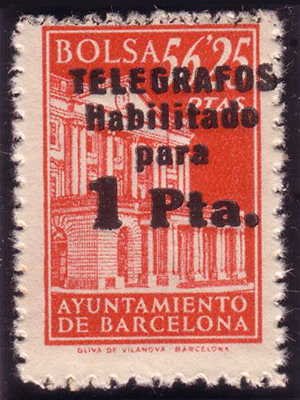
Three examples courtesy of Rolf Lamprecht.
1945 New Stock Exchange stamps (Type 21) overprinted and surcharged as Type 22.
White wove paper, no watermark. Perf. 11 x 11½. Control numbers on reverse in black.
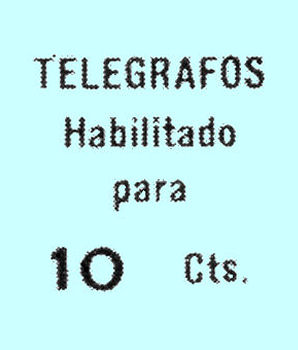 |
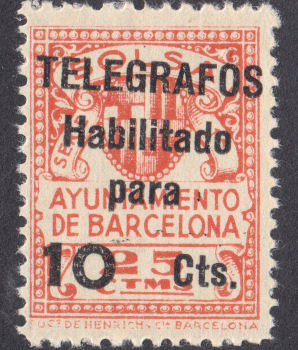 |
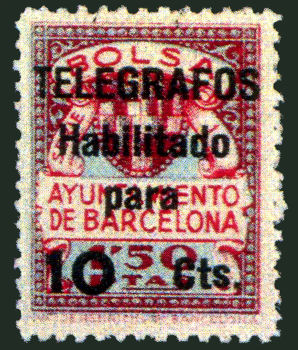 |
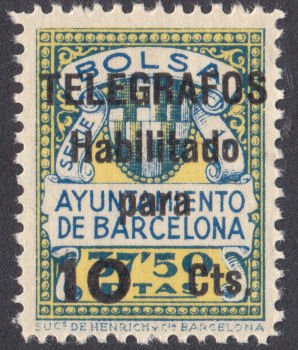 |
| Type 22 overprint | RH117 | RH118 - courtesy of John Barefoot | RH119 |
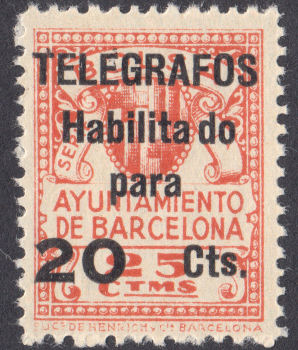 |
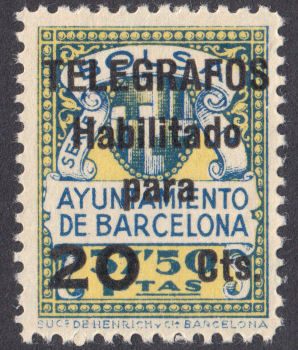 |
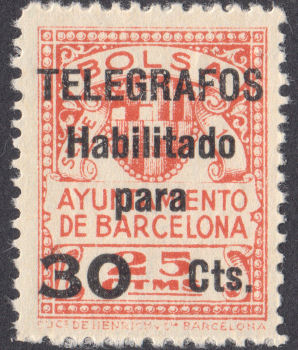 |
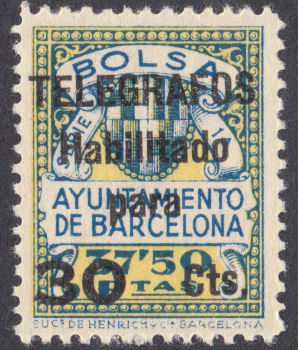 |
| RH120 | RH121 | RH122 | RH123 |
| RH # | Hisc. | Type. | Description | Mint | Used |
|---|---|---|---|---|---|
| RH117 | H113 | T21, 22 | 10c on 25c orange | 15.00 | - |
| *RH118 | - | T21, 22 | 10c on 1P50c red and pale blue | - | - |
| RH119 | H114 | T21, 22 | 10c on 37P50c blue and yellow | 15.00 | - |
| RH120 | H115 | T21, 22 | 20c on 25c orange | 15.00 | - |
| RH121 | H116 | T21, 22 | 20c on 37P50c blue and yellow | 15.00 | - |
| RH122 | H117 | T21, 22 | 30c on 25c orange | 15.00 | - |
| RH123 | H118 | T21, 22 | 30c on 37P50c blue and yellow | 15.00 | - |
*John Barefoot also lists a 10c on 1P50c red on pale blue for the same price, but I have not seen this. Hiscocks left H119 vacant.
Since I am re-numbering, I will reserve a space for it. Anyone have a scan.
Valencia
1963 Thick white wove paper. No watermark. Perf. 13¼. No control numbers. Sheets of 100 (10 x 10).
Imprint of F.N.M.T. - This stands for Fábrica Nacional de Moneda y Timbre, the Spanish Mint.
A compulsory surcharge to raise money for diverting the river Turia, obligatory on certain days.
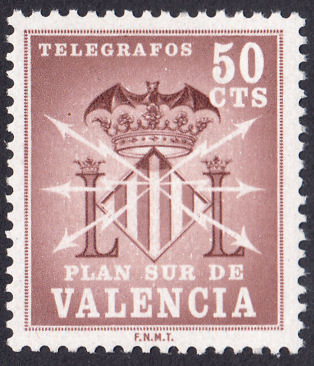
Hiscocks Type 23
| RH # | Hisc. | Type. | Description | Mint | Used |
|---|---|---|---|---|---|
| RH124 | H120 | T23 | 50c reddish brown | 1.00 | 0.50 |
Villada (Palencia)
1901 Lithographed on white wove paper. No watermark. Perf. 11½.
Sheets of 4 x 5, imperf. around outer edges so that only 6 stamps per sheet (30%) are fully perforated. These are thus worth a small premium.

Hiscocks Type 24
| RH # | Hisc. | Type. | Description | Mint | Used |
|---|---|---|---|---|---|
| RH125 | H121 | T24 | 5c black | 10.00 | 10.00 |
| RH126 | H122 | T24 | 10c blue | 25.00 | 25.00 |
| RH127 | H123 | T24 | 50c red | 10.00 | 10.00 |
| RH127a | H123a | T24 | dark red | 12.50 | 12.50 |
| RH128 | H124 | T24 | 1p brown-lilac | 25.00 | 25.00 |
| RH128a | H124a | T24 | lilac red | 25.00 | 25.00 |
| RH128b | H124b | T24 | brown-violet | 25.00 | 25.00 |
Three 1p stamps scanned together.
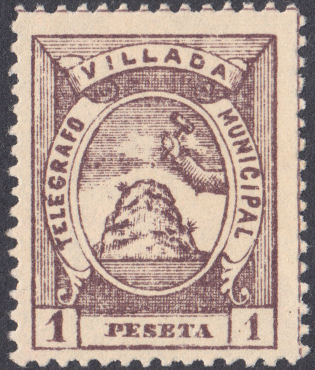 |
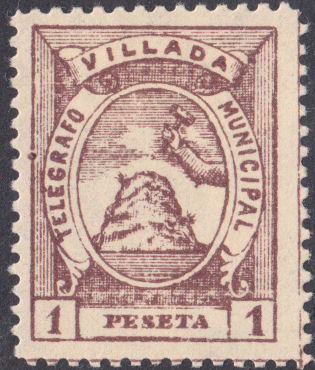 |
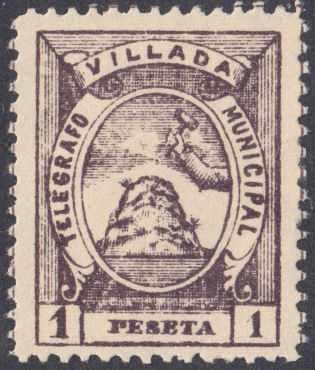 |
| H128 described as 'CASTAÑO LILA' (brown-lilac) |
H128a ? described as 'CASTAÑO' (brown) |
H128b ? described as 'CASTAÑO OSCURO' (dark brown) |
There is also some variability of the numerals on these.
Andalucia Railway Telegraph Stamps.
Ferro Carril Andaluces.
1883 Typographed on white wove paper. No watermark. Imperf.
Thin border lines on all sides.
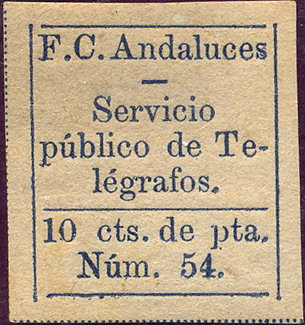 |
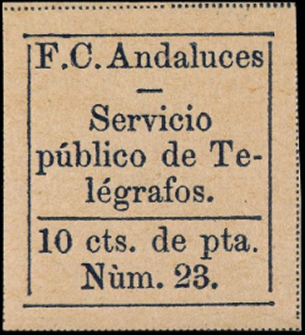 |
| RH1 - courtesy of Rolf Lamprecht. | RH1a - (Nùm for Núm, accent points up to left) courtesy of Soleryllach.com. |
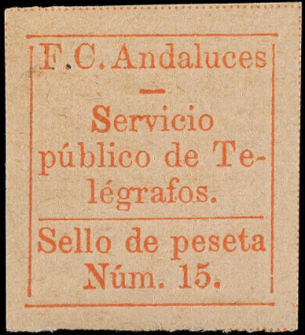 |
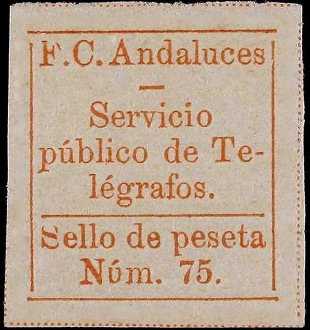 |
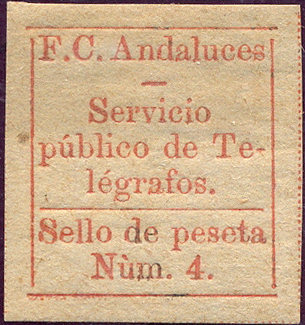 |
| RH2 - courtesy of Soleryllach.com. | RH2 (Núm with accent pointing up to right) |
RH2a (Nùm for Núm, accent points up to left) courtesy of Rolf Lamprecht. |
| RH # | Hisc. | Type. | Description | Mint | Used |
|---|---|---|---|---|---|
| RH1 | H1 | T1 | 10c blue | 30.00 | 20.00 |
| RH1a | - | Nùm for Núm | - | - | |
| RH2 | H2 | T1 | 1p brown-red | 40.00 | 30.00 |
| RH2a | - | Nùm for Núm | - | - |
1886 As above but perf. 13½
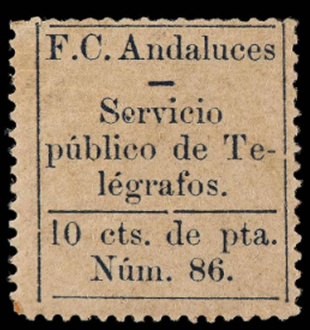 |
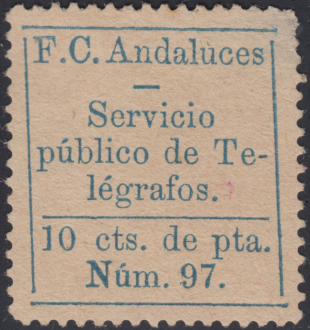 |
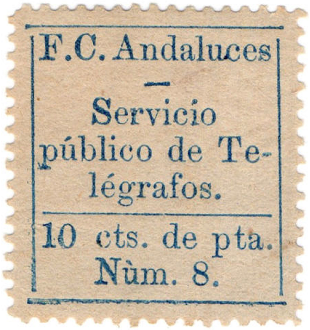 |
| RH3 - courtesy of Soleryllach.com. | RH3a - courtesy of Estudi Filatelic | RH3b (Nùm for Núm) - Lost in post |
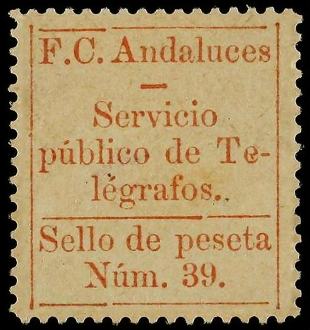 |
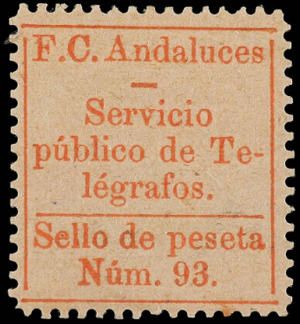 |
| RH4 (but all horizontal lines broken) | RH4 - courtesy of Soleryllach.com. |
| RH # | Hisc. | Type. | Description | Mint | Used |
|---|---|---|---|---|---|
| RH3 | H3 | T1 | 10c blue-black | 50.00 | 30.00 |
| RH3a | H3a | pale blue | 150.00 | 80.00 | |
| RH3b | - | Nùm for Núm | - | - | |
| RH4 | H4 | T1 | 1p red | 60.00 | 15.00 |
1892(?) As above but with thick lines on right and lower sides.
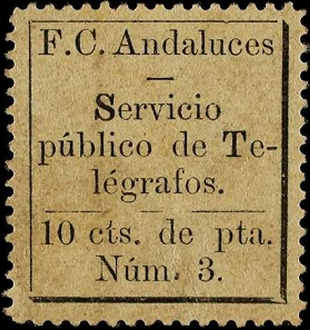
RH5
| RH # | Hisc. | Type. | Description | Mint | Used |
|---|---|---|---|---|---|
| RH5 | H5 | T1 | 10c black | 100.00 | 60.00 |
| RH6 | H6 | T1 | 1p brown-red | 200.00 | 120.00 |
1894(?) As above but with thick lines on all sides. Perf. 13¼
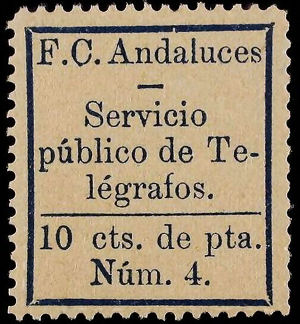 |
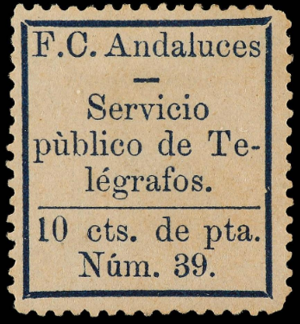 |
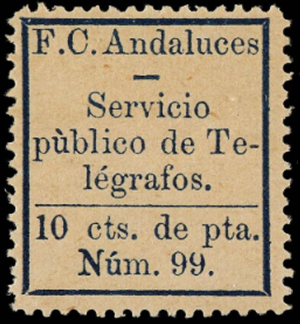 |
| RH7 (accent of ú in público normally pointing up to the right), broken 'f'. |
RH7a (pùblico for público) courtesy of Soleryllach.com. |
RH7a (pùblico for público) courtesy of Soleryllach.com. |
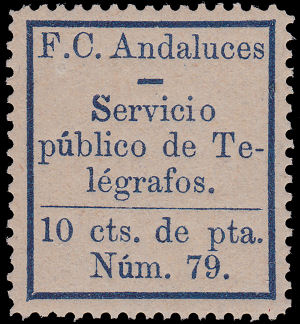 |
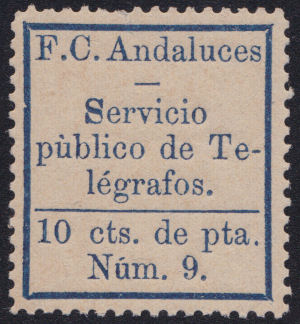 |
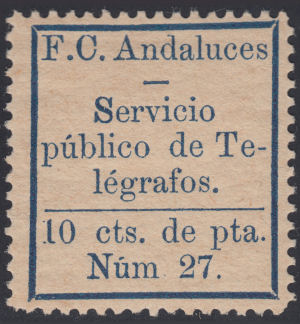 |
| RH8 | RH8a (pùblico for público) (accent pointing up to left) |
RH8b - courtesy of Estudi Filatelic (no dot after Núm) |
| RH # | Hisc. | Type. | Description | Mint | Used |
|---|---|---|---|---|---|
| RH7 | H7 | T1 | 10c dark blue | 20.00 | 15.00 |
| RH7a | - | pùblico for público | - | - | |
| RH8 | H8 | T1 | 10c ultramarine | 30.00 | 20.00 |
| RH8a | - | pùblico for público | - | - | |
| RH8b | - | no dot after Núm | - | - | |
| RH9 | - | T1 | 1p brown-red | 100.00 | 80.00 |
Hiscocks added the following 2 notes:
| Note. 1 These stamps were numbered from 1 to 100 in the sheet. |
| Note. 2 These stamps are variable in detail - missing accents. punctuation etc. |
Ferro Carril de Baeza a Algeciras.
1883 As above but "F.C. de B. á A". Perf. 11½.
Anyone have a scan ?
| RH # | Hisc. | Type. | Description | Mint | Used |
|---|---|---|---|---|---|
| RH10 | H9 | (T1) | 5c black | 250.00 | - |
| RH11 | H10 | (T1) | 10c yellow-green | 250.00 | - |
| RH12 | H11 | (T1) | 50c sky blue | 250.00 | - |
| RH13 | H12 | (T1) | 1p dark red-brown | 250.00 | - |
Hiscocks added the following 2 notes:
| Note. 1 Notes 1 and 2 above apply. |
| Note. 2 The issue dates of Nos. 3-12 are in doubt. Modern Spanish catalogues give 1883 for all issues but a reference of 1893 gives 1883 for the imperf. and 1886 for the perforated and refers to the thick line type (Nos. 5 and 6) as a recent innovation. |
plazas de soberanía
("places of sovereignty")
I have only recently become aware of these, analogous to the British enclave of Gibraltar, Spain had its' own enclaves from early days on the North African coast.
Like Gibraltar, they were very defensible. I really do not know if they ever used telegraph stamps, but I do know that Ceuta and Melilla had wireless telegraph sets by 1906.
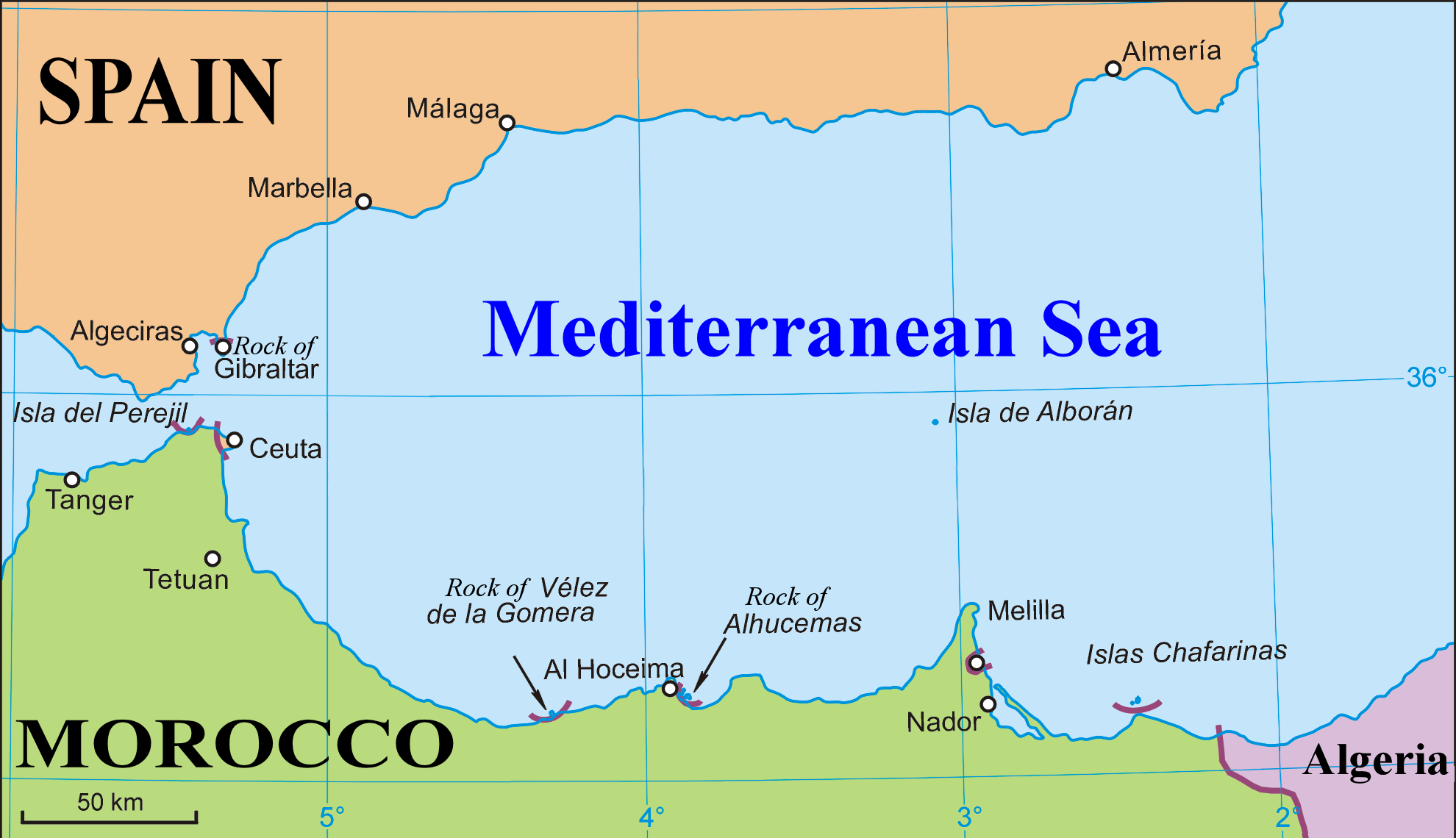
If they used stamps at all, they would probably have been from the Spanish mainland rather than from Morocco and may or may not have been identifiable by cancellation.
Worth looking out for, but probably very rare to non-existent.
1900 Hoja Telegrafica
This appears to be a combination of a telegraph version of a 1900-05 King Afonso XIII postage stamp (Scott 284),
with a replacement for the 1898 War Tax stamp (Scott MR27).
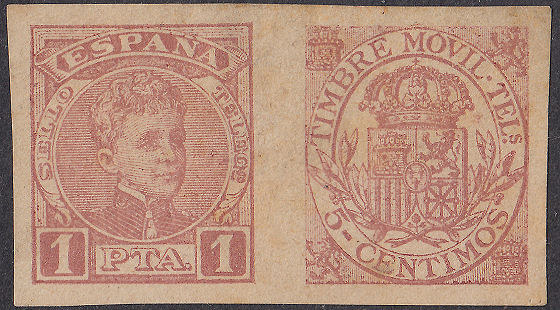
There was also a 50c + 5c version in grey for sale on Delcampe recently listed as a proof.
Richard Ballhagen tells me that it is listed in an old Galvez catalogue of 1946, along with the 50c + 5c type and was apparently on telegraph stationery.
I now have Galvez, 1951 and it is on page 151. They presumably cover the cost of the telegram plus a 5c tax on it.
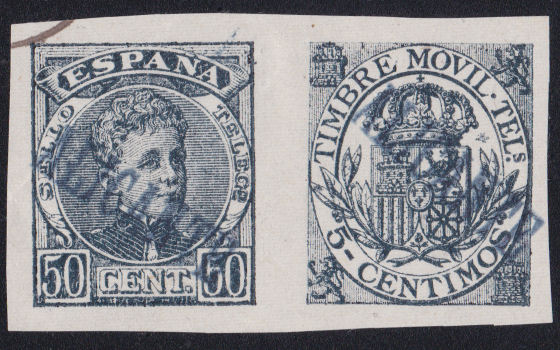
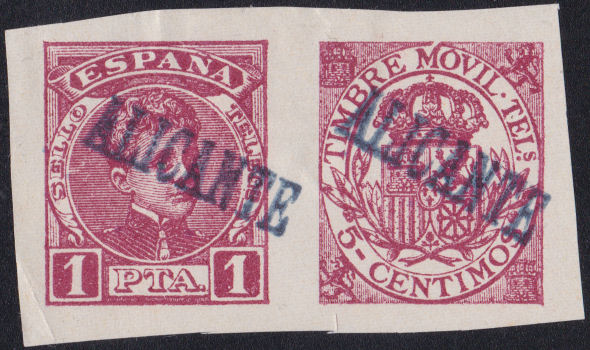
Here are two examples used in Alicante. The 1P is significantly darker than the one above, so perhaps that is a proof.
Two more examples courtesy of Rolf Lamprecht.
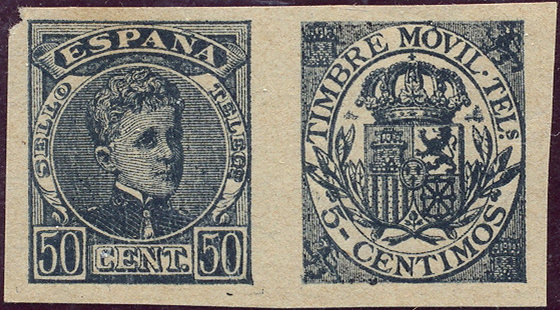
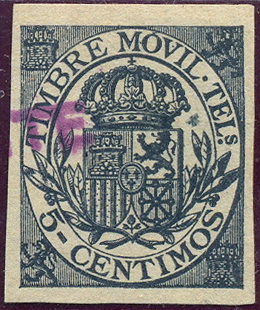
| RH# | Hisc. | Description | Entire Sheet | Cutouts | ||
|---|---|---|---|---|---|---|
| Mint | Used | Mint | Used | |||
| RH-S1 | - | 50c + 5c blue | 125.00 | - | 15.00 | 7.50 |
| RH-S2 | - | 1P + 5c carmine | 100.00 | - | 15.00 | 7.50 |
Anyone have an image of a complete form using these ?
Hoja de Reintegro (Repayment sheet).
The earliest examples that I have seen of this usage is 5 April 1951 as shown below.
Images courtesy of GloriaErcole on Delcampe. (click images for listing)
The stamps are cancelled with the date and "CADIZ" in separate operations. Spacing between them is variable.
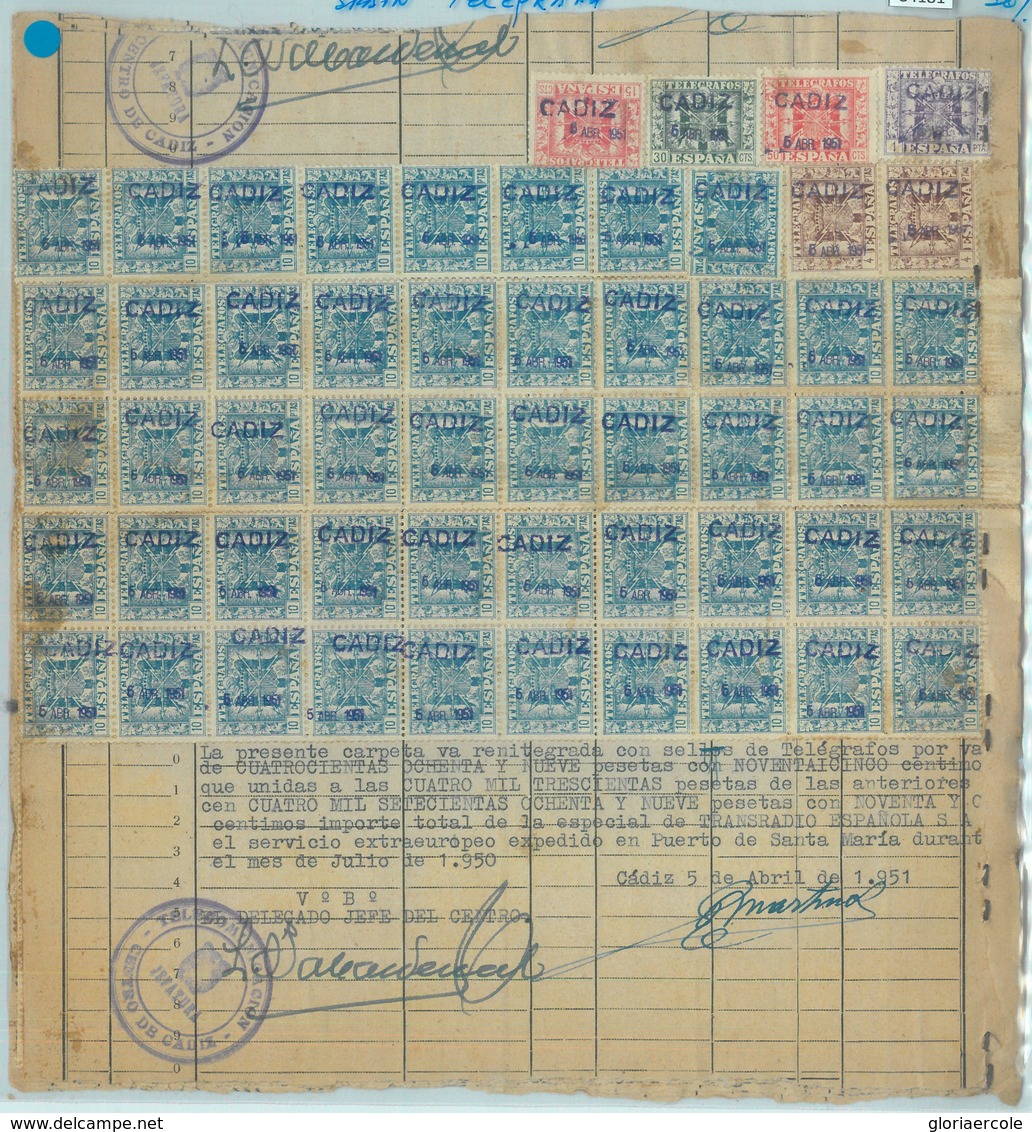
Some of the writing may be under the stamps, but what is visible reads :
"La presente carpeta va renitegrada[SIC] con sellos de Telégrafos por va de CUATROCIENTAS OCHENTA Y NUEVE pesetas con NOVENTAICCINCO centimo
que unidas a las CUATRO MIL TRESCIENTAS pesetas de las anteriores cen CUATRO MIL SETECIENTAS OCHENTA Y NUEVE pesetas con NOVENTA Y C[INCO]
centimos importe total de la especial de TRANSRADIO ESPAÑOLA S.A. el servicio extraeuropeo expedido en Puerto de Santa María durant
el mes de Julio de 1.950 Cádiz 5 de Abril de 1.951"
A translation (with much help from Google) goes something like :
"This folder is returned with Telegraph stamps for FOUR HUNDRED AND EIGHTY-NINE pesetas and NINETY-FIVE cent
that together with the FOUR THOUSAND THREE HUNDRED pesetas of the previous cen FOUR THOUSAND SEVEN HUNDRED EIGHTY NINE pesetas with NINETY FIVE
cents total amount of the special of TRANSRADIO ESPAÑOLA S.A. the extra-European service issued in Puerto de Santa María during
the month of July 1950 Cádiz April 5, 1951"
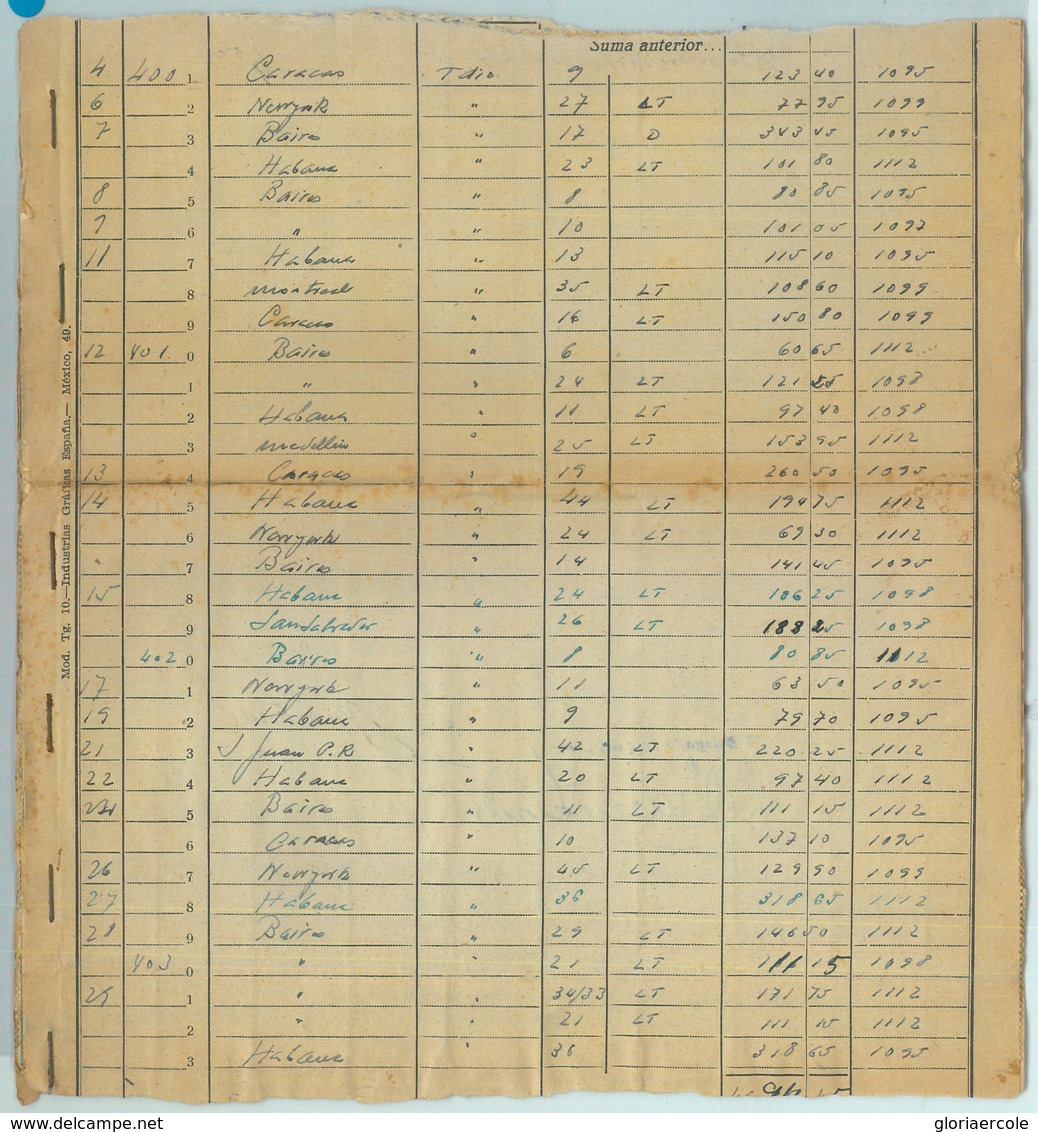
Stapled to it is an itemised listing. The side of that has a printers imprint.

The next examples that I have seen of this usage is 30 April 1951 as shown below.
This is also courtesy of GloriaErcole on Delcampe. (click images for listing)
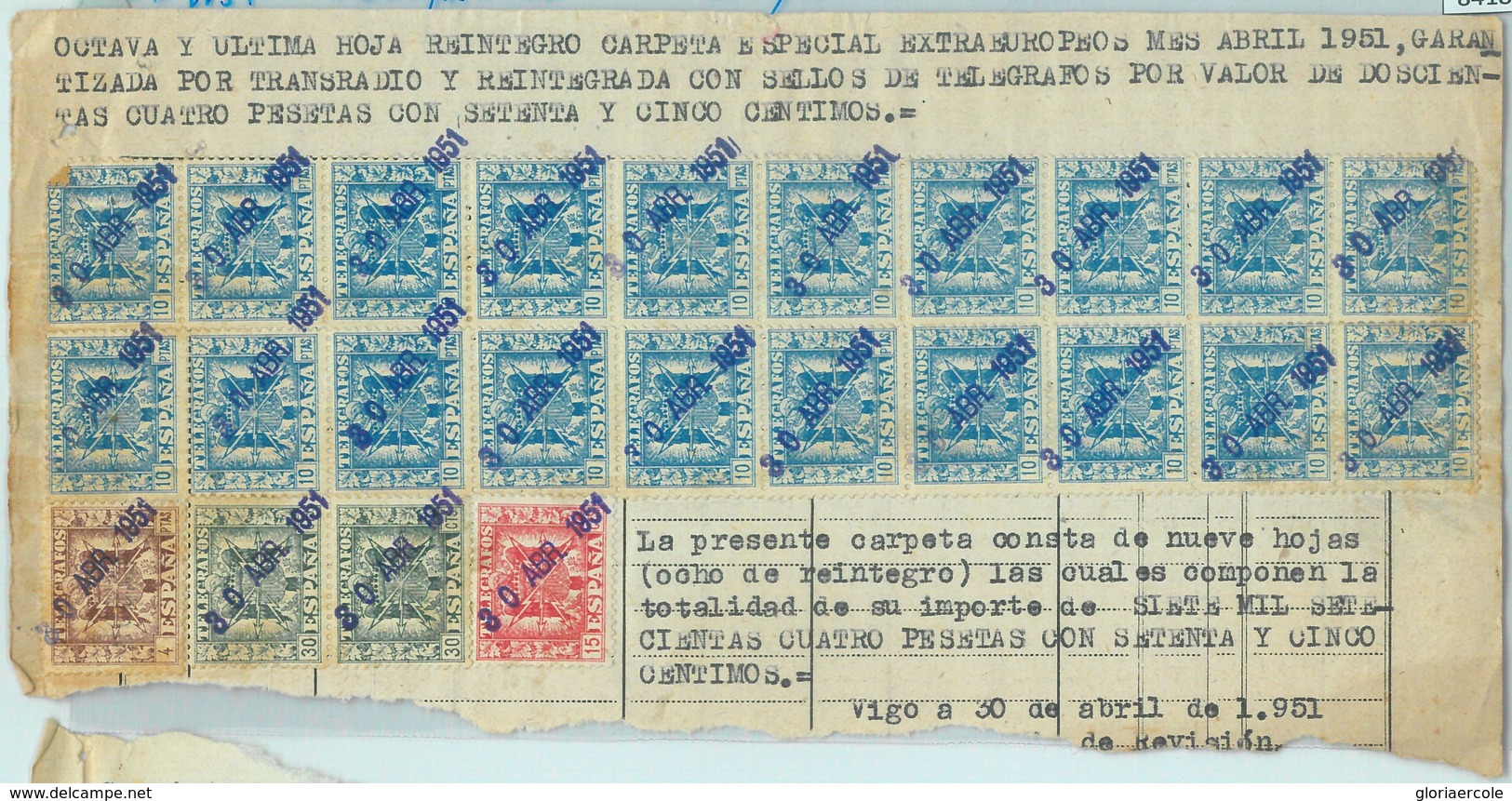
The wording is similar, though with no mention of Transradio Española.
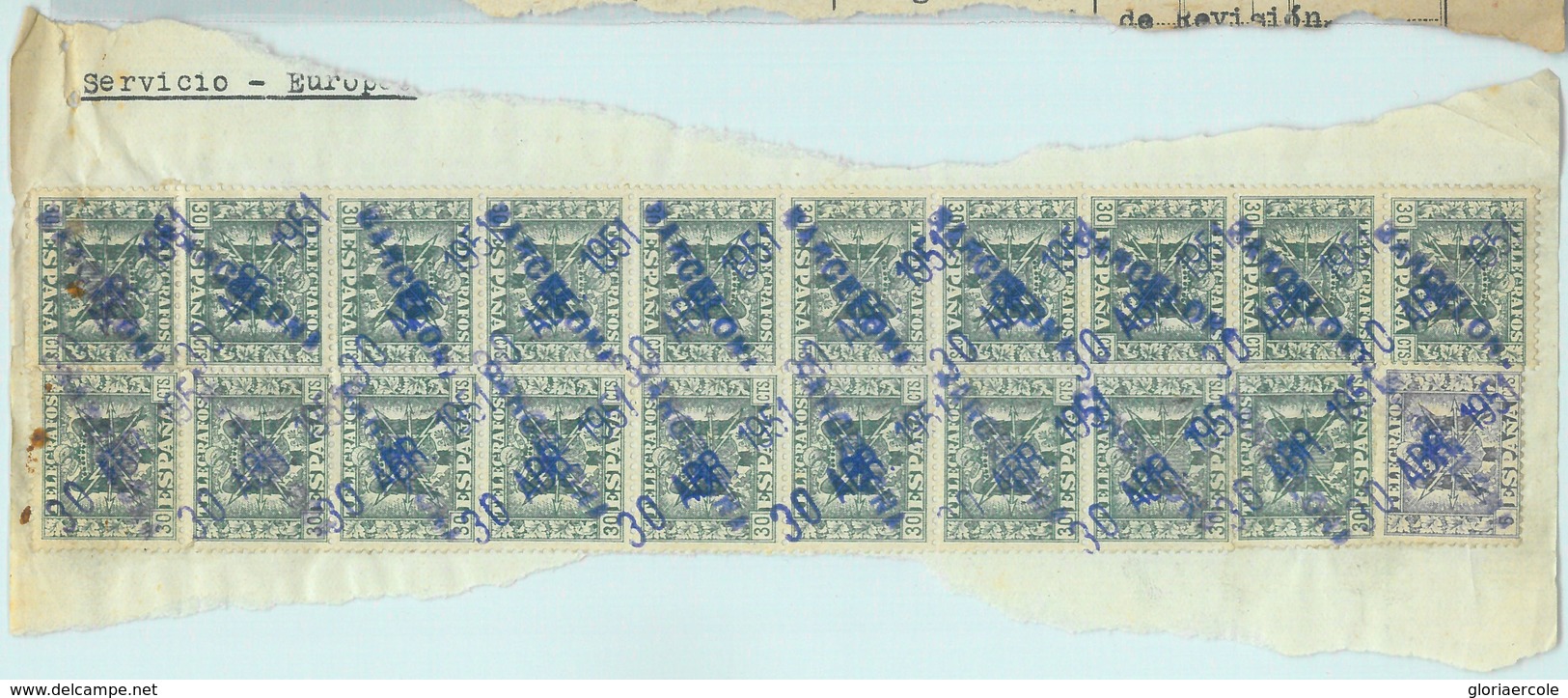
There are stamps on the front and back. They are all cancelled with the date, but only those on the back (20 x 30c) have additionally "BARCELONA".
The total adds up to 210P 75c.
It is clear that these need a lot of stamps, mostly high value ones. That is probably why the next type was brought into existence.
1951? Litho. White wove paper with security lines on the front.
Space for additional adhesives on the back.
These were perhaps used for repayment of telegram or telephone bills. the impressed stamp on the front is the same size and design as the adhesive stamps.
These appear to have been sold in the form of large sheets having at least 9 'Fraccions' that were subsequently cut from it, completed and signed to repay the cost of telegrams.
Up to 8 additional stamps can be added on the back of one out of a batch. Each was intended for part or whole of a month and I have seen used ones from 1951 to 1955.
They are embossed with a circular 'TELECOMUNICACION' seal in a similar design to the Telegraph stamp.
These seem to be ideally suited for paying telephone bills also, but they have a field labelled "Núm. de telegramas".
An imprint at the bottom of the front reads "FCA. NAL. DE MONEDA Y TIMBRE".
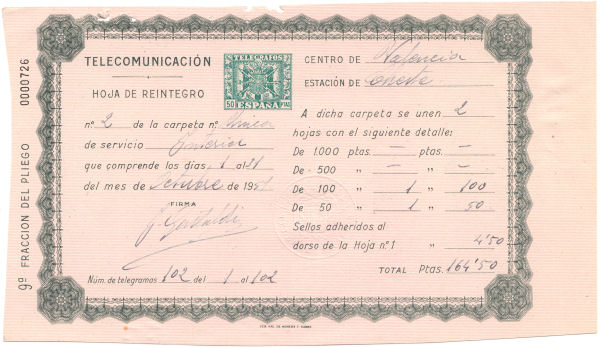
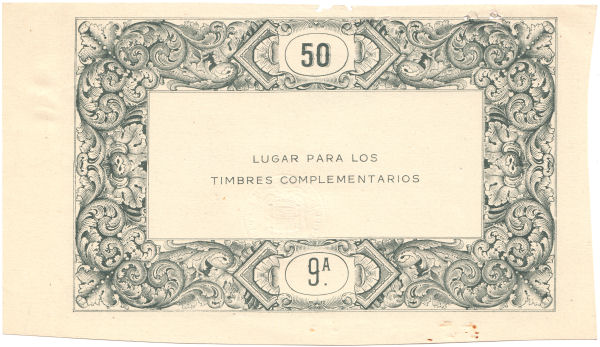
Front and back of the 50p value at 75dpi. This is dated October 1951 and was one of two cards used to pay 164Pt50 for 102 telegrams.
I am not sure of the significance of the 'Fraccion del pliego', but this is 9A, as marked on the back as well as on the front. I have also seen 1A, 4A, 6A and 7A.
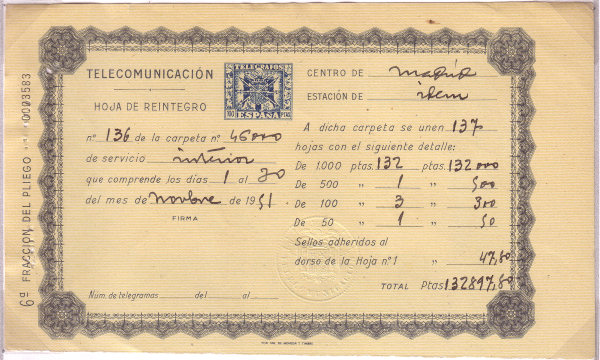
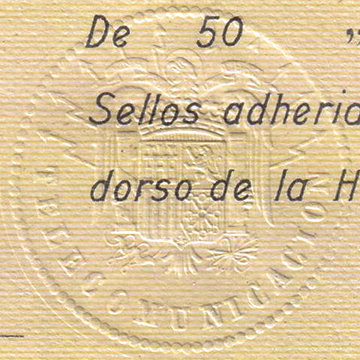
Front of a 100p value dated November 1951 at 75dpi and a closeup (300dpi) of the Telecomunicacion 'seal' that each of these bear (courtesy of Rolf Lamprecht).
This was used for part of the payment of 132897Pt80 that required a total of 137 cards to pay.
Some helpful translations:
Fraccion del pliego = Fraction of sheet
Hoja de Reintegro. = Repayment sheet
A dicha carpeta se unen. = Joined in folder
(they seemed to have been stapled in batches for a particular bill)
hojas con el siguiente detalle: = sheets detailed below
Sellos adheridos al dorso de la Hoja no 1 = Stamps attached to the back of sheet 1
Lugar para los timbres complementarios = Place for supplementary stamps
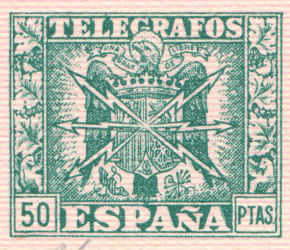
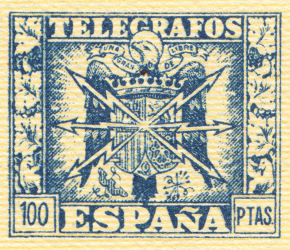
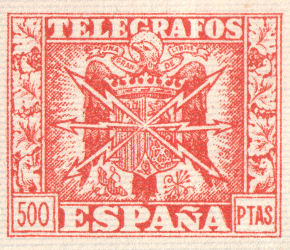
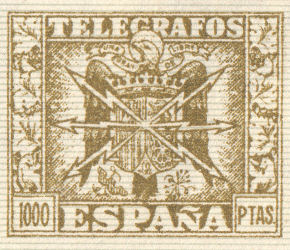
50p to 1000p values of impressed stamps at 300dpi.
| RH# | Hisc. | Type. | Description | Mint | Used |
|---|---|---|---|---|---|
| RH-R1 | - | T1 | 50p green and dark green on pink security lines | - | 10.00 |
| RH-R2 | - | T1 | 100p blue and grey-blue on yellow security lines | - | 12.00 |
| RH-R3 | - | T1 | 500p red and scarlet on mauve security lines | - | 15.00 |
| RH-R4 | - | T1 | 1000p brown and sepia on slate security lines | - | 20.00 |
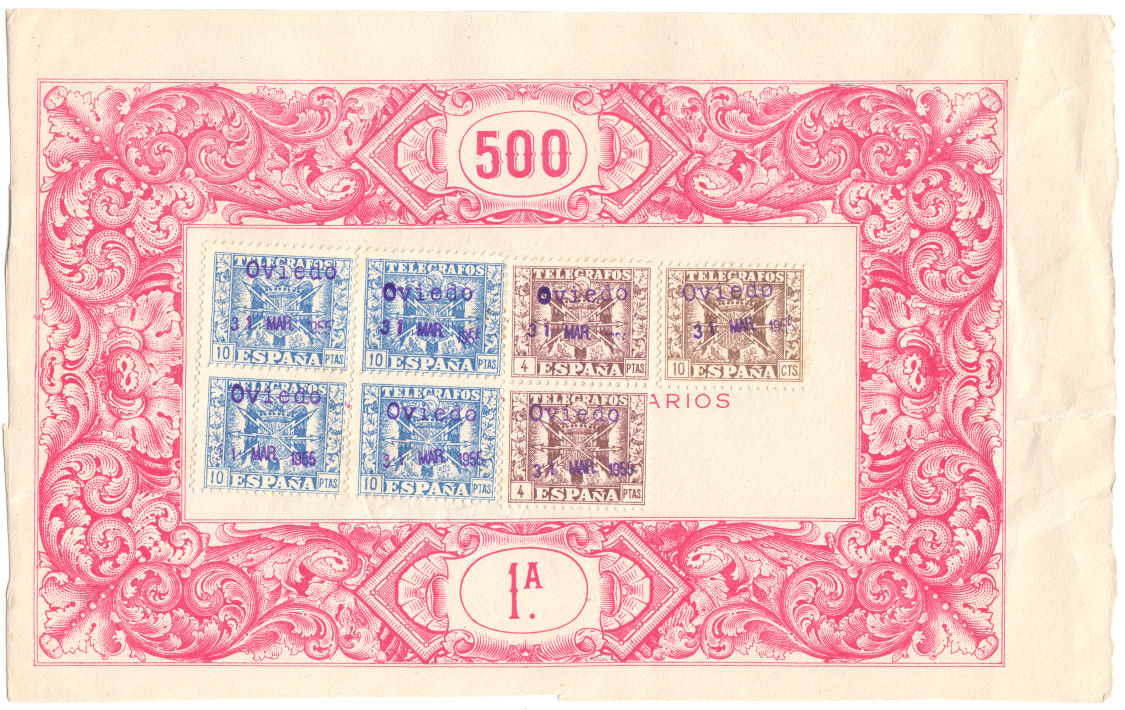
The back of a 500p sheet (at 150dpi) with 48p10 worth of the standard adhesives, cancelled with a fairly distinctive mark for Oviedo dated 31 March 1955.
John Barefoot states that the perforated stamps were withdrawn 1st January 1952, but they clearly still had a use after that.
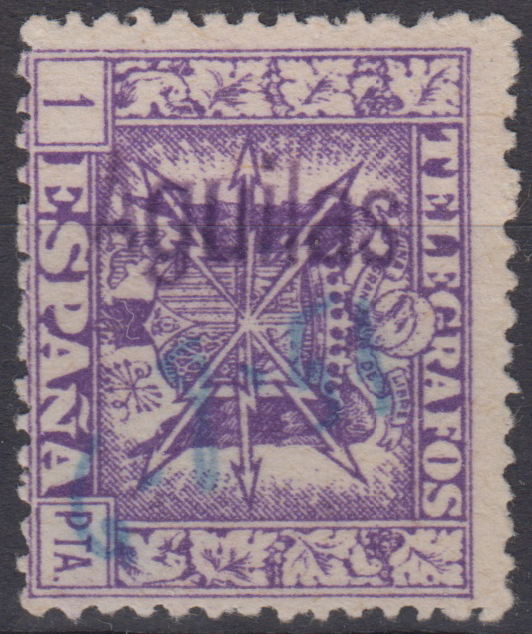
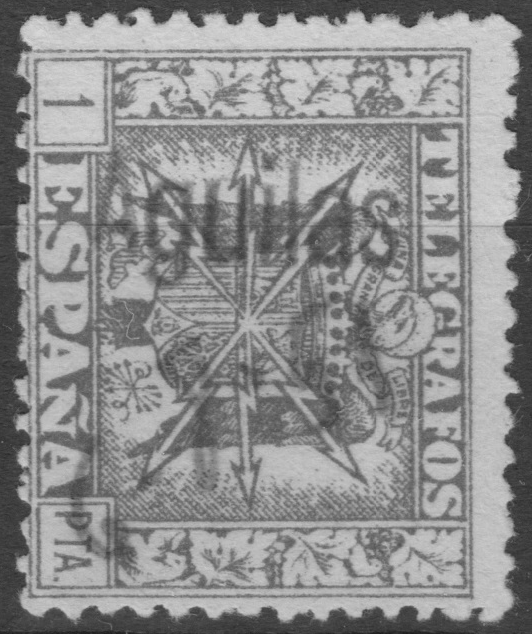
The only examples I have with stamps added to the back were used in Oviedo, but I think this was used similarly in Aguilas with the date of 6/9/51 written by hand in blue underneath.
I could be wrong of course. Image courtesy of Bob Bidner, I have added the red-channel image as it may make the date clearer.
These images come from SoleryLlach.com
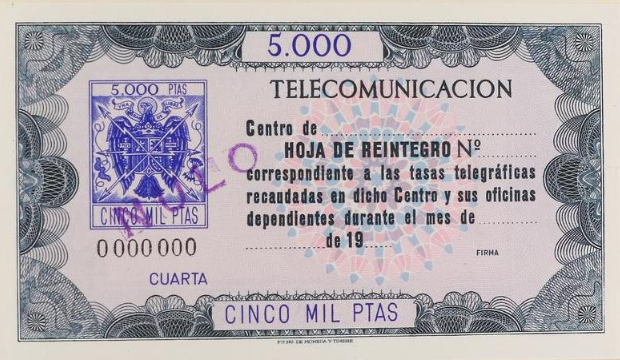
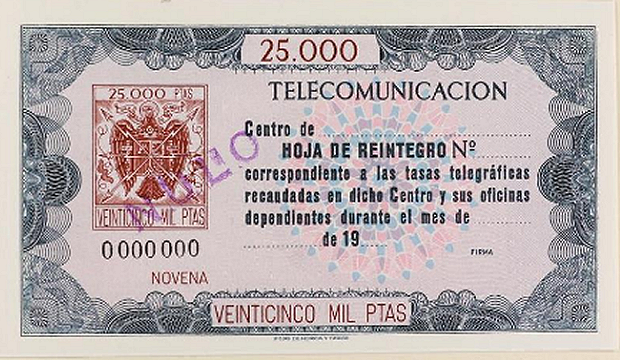
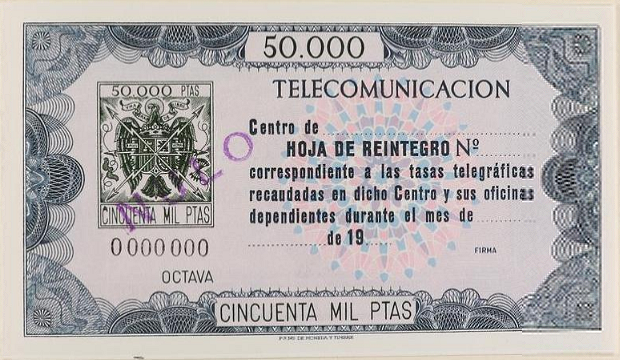
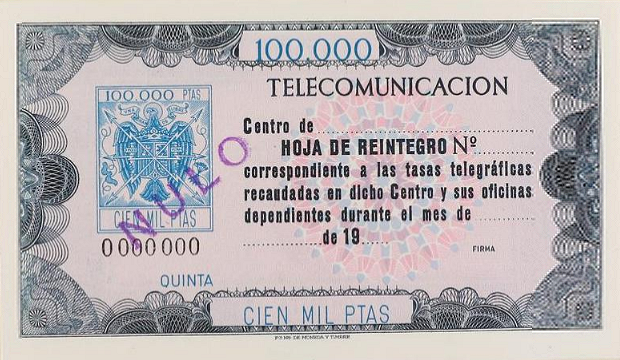
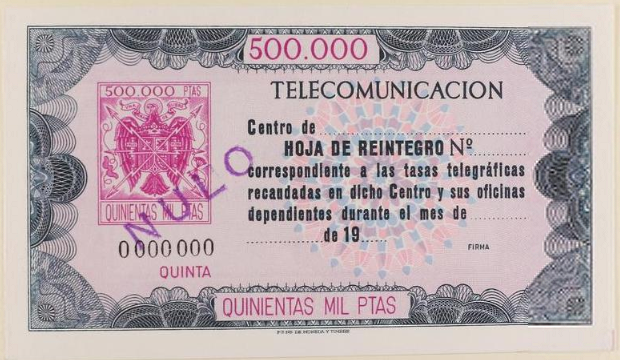
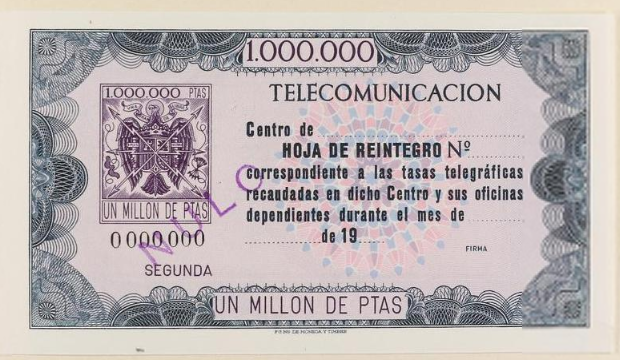
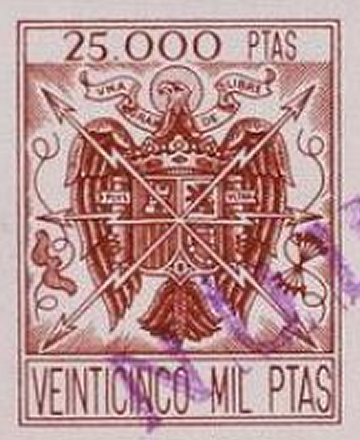
The Lot (444) is described as "ESPAÑA: TELEGRAFOS. 1973. HOJA DE REINTEGRO DE TASAS TELEGRÁFICAS. Libro de Muestra con billetes de 50 pts. hasta 1.000.000(en total 11) con numeración 0.000.000. RARÍSIMO."
So these would seem to be in a 1973 sample booklet of 11, from 50pts to 1,000,000 pts, of which 6 are illustrated. The 'stamps' printed on them are telegraphic in style, but have no country or purpose marked on them.
They are though cancelled with "NULO" across them. They are all numbered 0000000 and variously marked 'SEGUNDA', 'CUARTA', 'QUINTA', 'OCTAVA' and 'NOVENA'.
They also appear to have the same imprint at the bottom reading "FCA. NAL. DE MONEDA Y TIMBRE", but I have no idea of the size or what, if anything, is on the back.
I also do not know if these were put into use or what, if anything came between these and the type shown above.
At the time of writing (25 November 2021), these are still available at €500.
'Huérfanos de Telégrafos' and 'Hogar Telégrafico' stamps.
These mean 'Telegraph Orphan' and 'Telegraph Home' respectively and were charity stamps intended
to raise money for dependents of deceased telegraph workers.
According to Hiscocks, these were optional and he therefore did not list them.
It should perhaps be pointed out though that failure to pay would be a little like
failing to tip at a restaurant. It may affect your service next time.
Telephone stamps.
In 1884 A royal decree establishes a state monopoly over all telephone services.
In 1886 the take-over of phone service by private companies is authorized due to lack of interest on the part of the Spanish government.
20 April 1896 An intercity telephone line between Barcelona, Saragossa and Madrid is inaugurated.
National Intercity Northeast Telephone Network.
1905? Photo. White wove paper. No watermark. Perf. 11¾. Red control number in front bottom right.
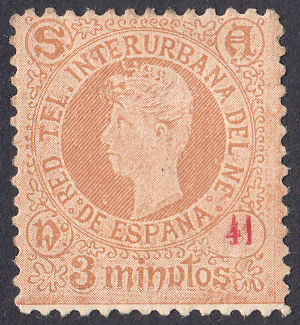
Head of the manager María Cristina
| RH # | Hisc. | Type. | Description | Mint | Used |
|---|---|---|---|---|---|
| RH-T1 | - | T1 | 3 Minutes yellow brown | 310.00 | - |
There is no mention of Telephone stamps in the Galvez Catalogue.
As of January 2018, I am also told by Formafil Club Filatelia that the Edifil Catalogue does not list it.
This is line-perforated and gummed, so is unlikely to be a proof, I find it strange that I can find no other references to it.
UPDATE: I have now(8 December 2022) seen another one where it has already been sold. It is the same, except it has selvedge at the bottom and is numbered 58.
My information about the date and owner of the head comes from there, so they clearly have information from somewhere.
I can see no obvious way to talk to them. Perhaps it is now in Edifil. They say it is catalogued at €500.
Anyone have further information on these ?
